past exhibition
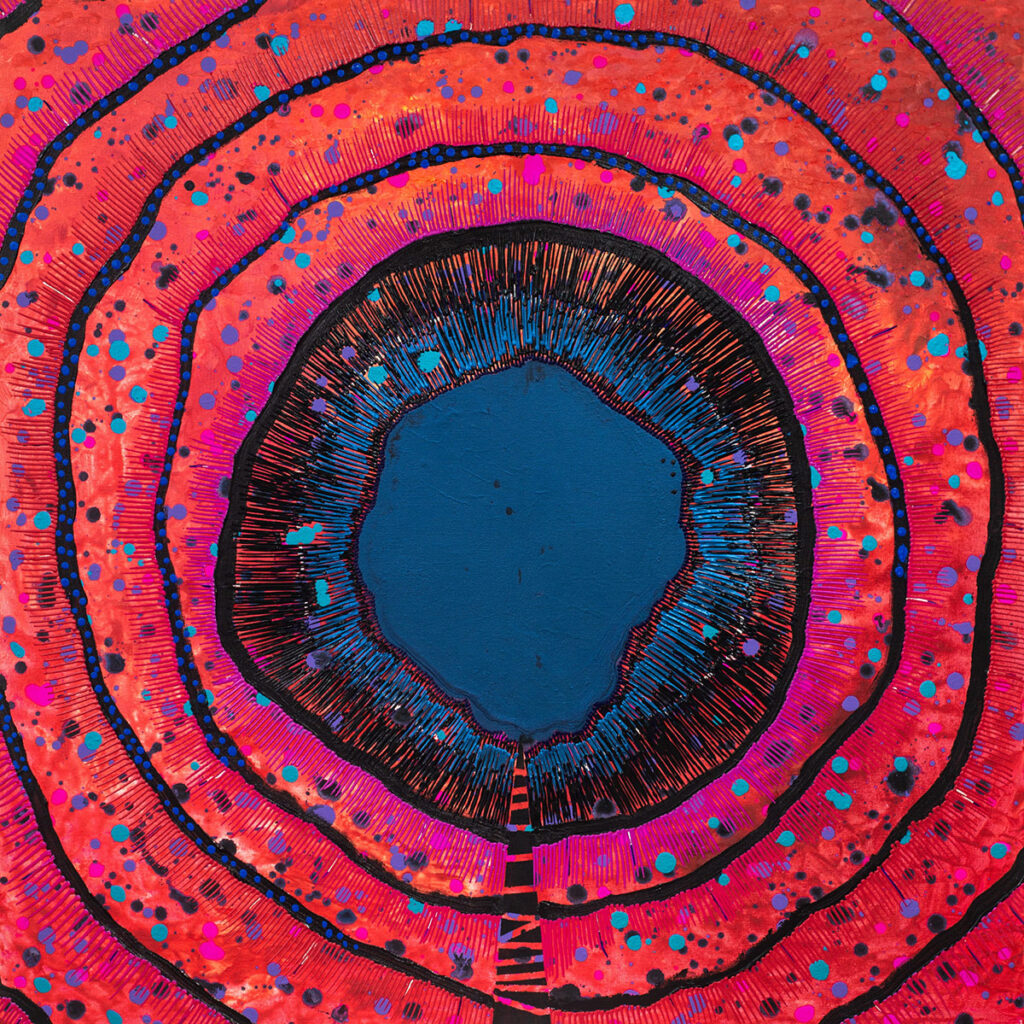
EMERGE 2020
Graduating Fine Art Students of New England
Sale of Work
If you are interested in supporting these artists during this challenging time, please inquire with the artists directly through the contact information associated with each piece.
Gallery 263 does not require a percentage of the sale, but a small donation from the artist is encouraged. As a small nonprofit art space, we depend on our communities’ support to keep our programs running, our staff supported, and our mission-driven impact flourishing.
EMERGE 2020: Graduating Fine Art Students of New England, a regional juried exhibition, features the work of twenty artists who are graduating or expected to graduate from a New England-based fine arts program during this unprecedented time. Celebrating artistic innovation and thoughtful production, this exhibition features a range of media, including video, sound, painting, sculpture, and photography. This show was juried by the staff and board of Gallery 263.
Featured artists
Ben Carroll
Massachusetts College of Art & Design, BFA
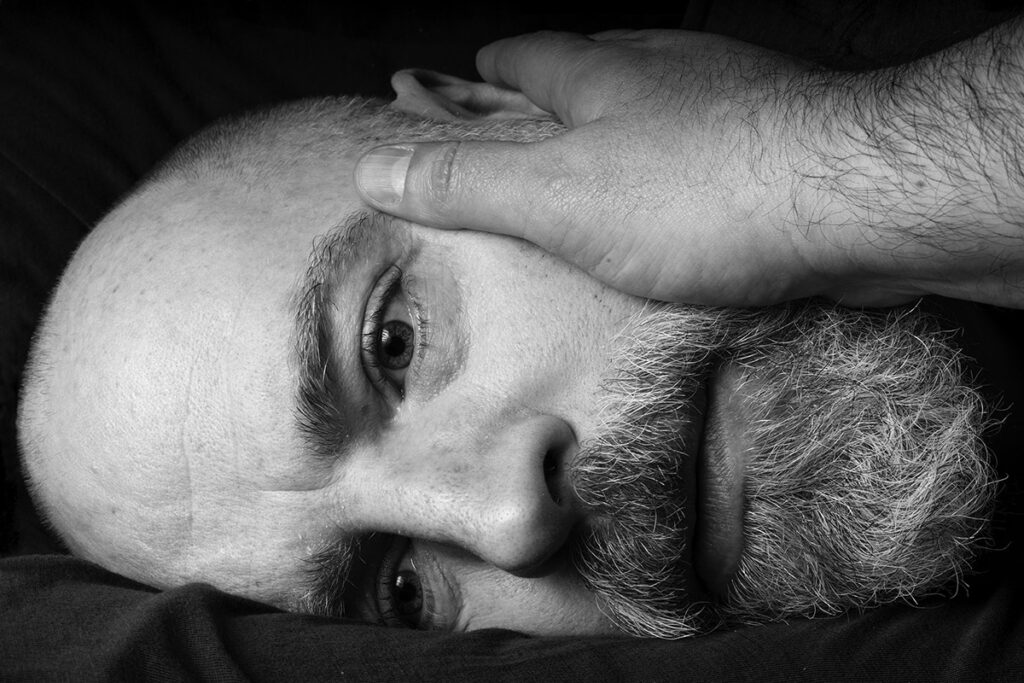

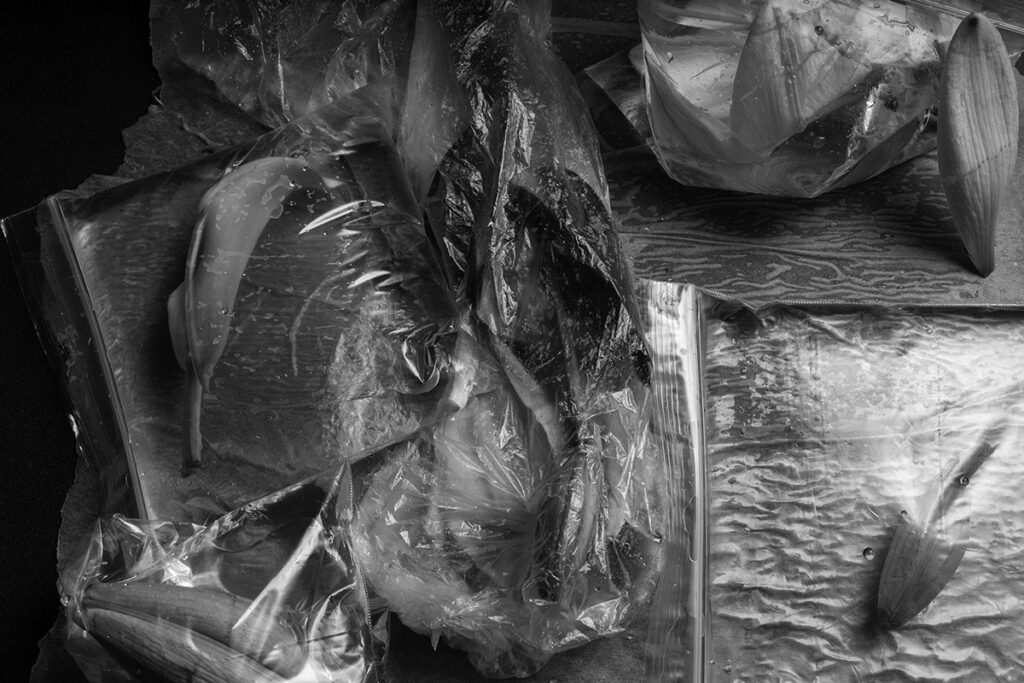
This body of work focuses on grief and intimacy with my husband of 18 years, and the impact of mental illness on our lives. I am looking at what it means for two middle-aged men to be in a long-term relationship obscured by the complexities of loss and illness.
In the course of our marriage, Drew and I have suffered some wicked and devastating family losses. I am examining how grief and coping transform us and our relationship to the space we inhabit in the world. I look at everyday nuances, the chaos and beauty of life, while underscoring what is real, and often overlooked. Loss ravages us in the way the elements lay their hand on the natural world. There is disintegration, deterioration. I see this assault as inevitable, devastating, and beautifully illustrative of the human experience.
When there is loss, we are robbed of our breath. I envision that the ghosts of those passed take up residence in the shoebox apartment of our lungs, leaving little room for catching breath or exhalation. As time heals and memory dissipates, the ghosts slowly crawl out and away as life stumbles forward. I assume they’ll be back, and, in time, others too will haunt and squat.
Camilla Kathleen Campos Maloney
Massachusetts College of Art & Design, BFA
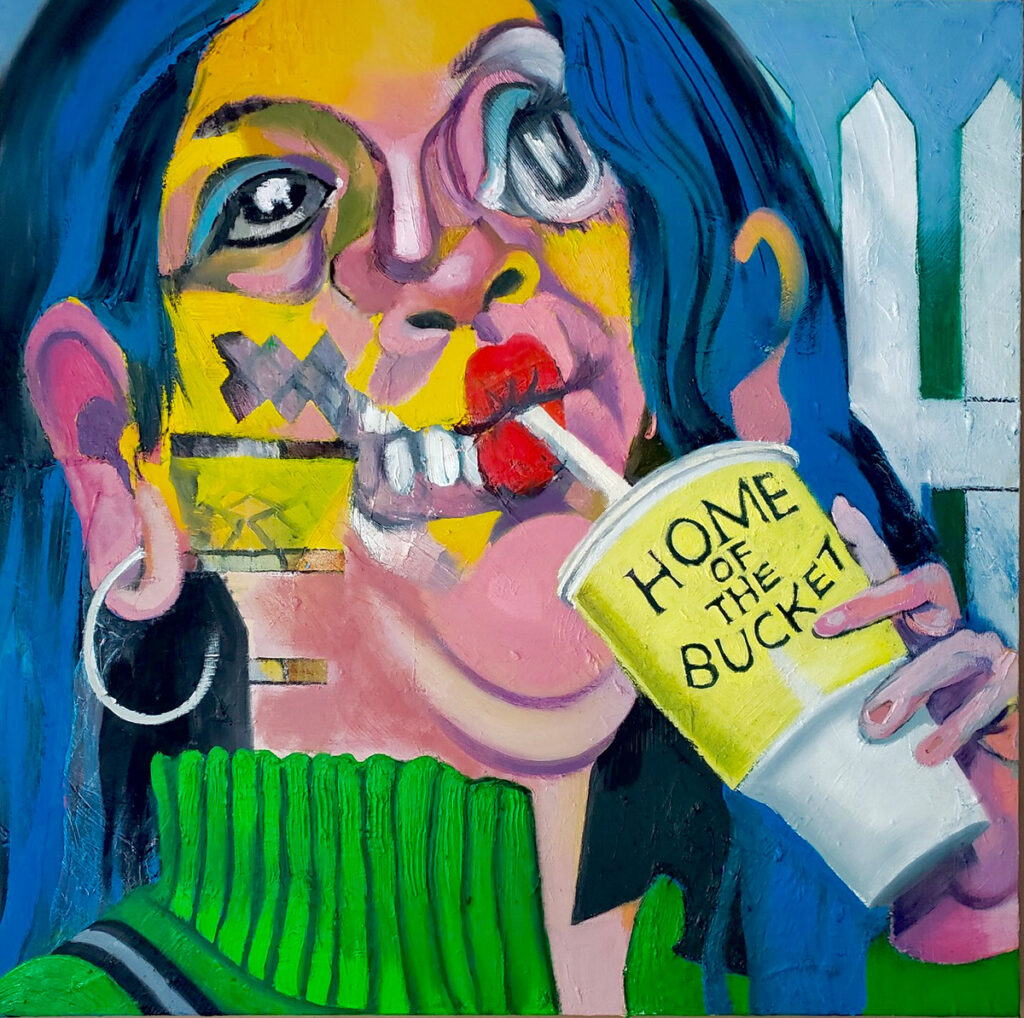
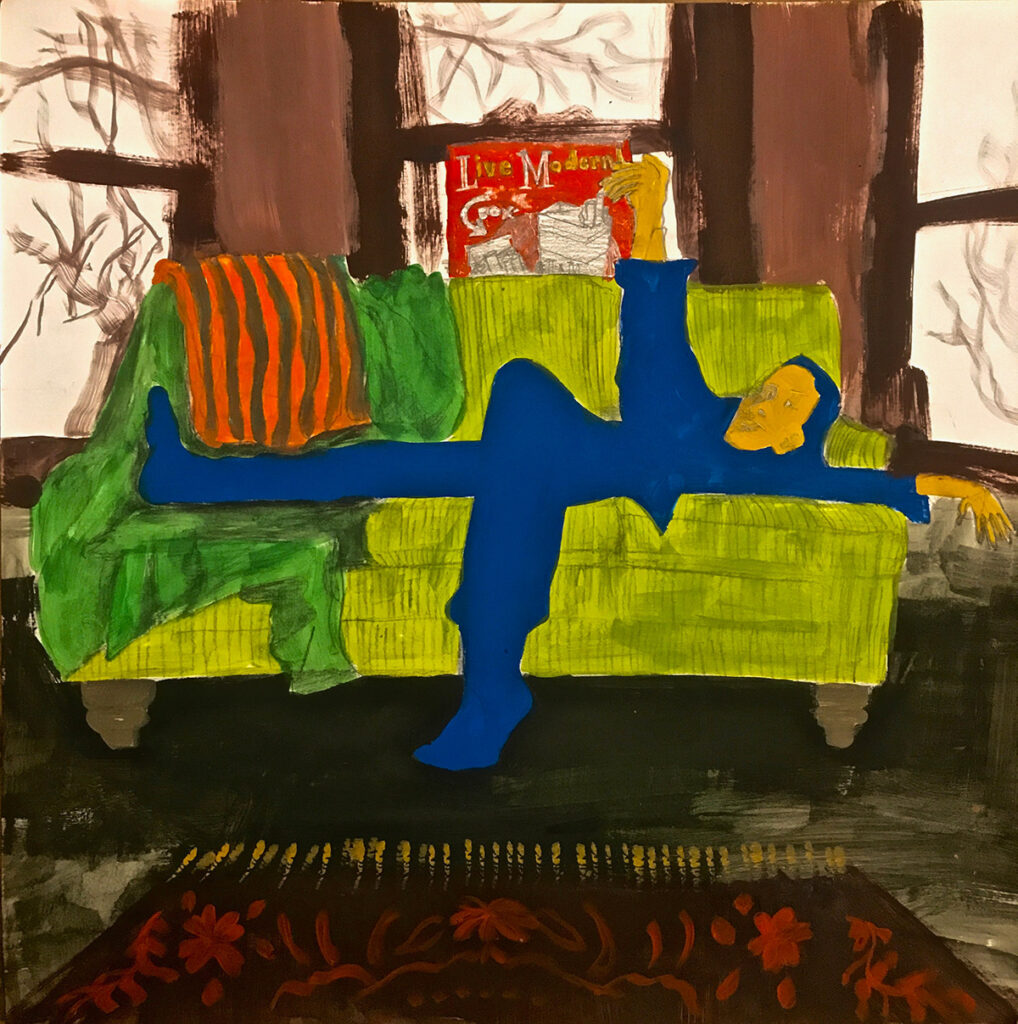
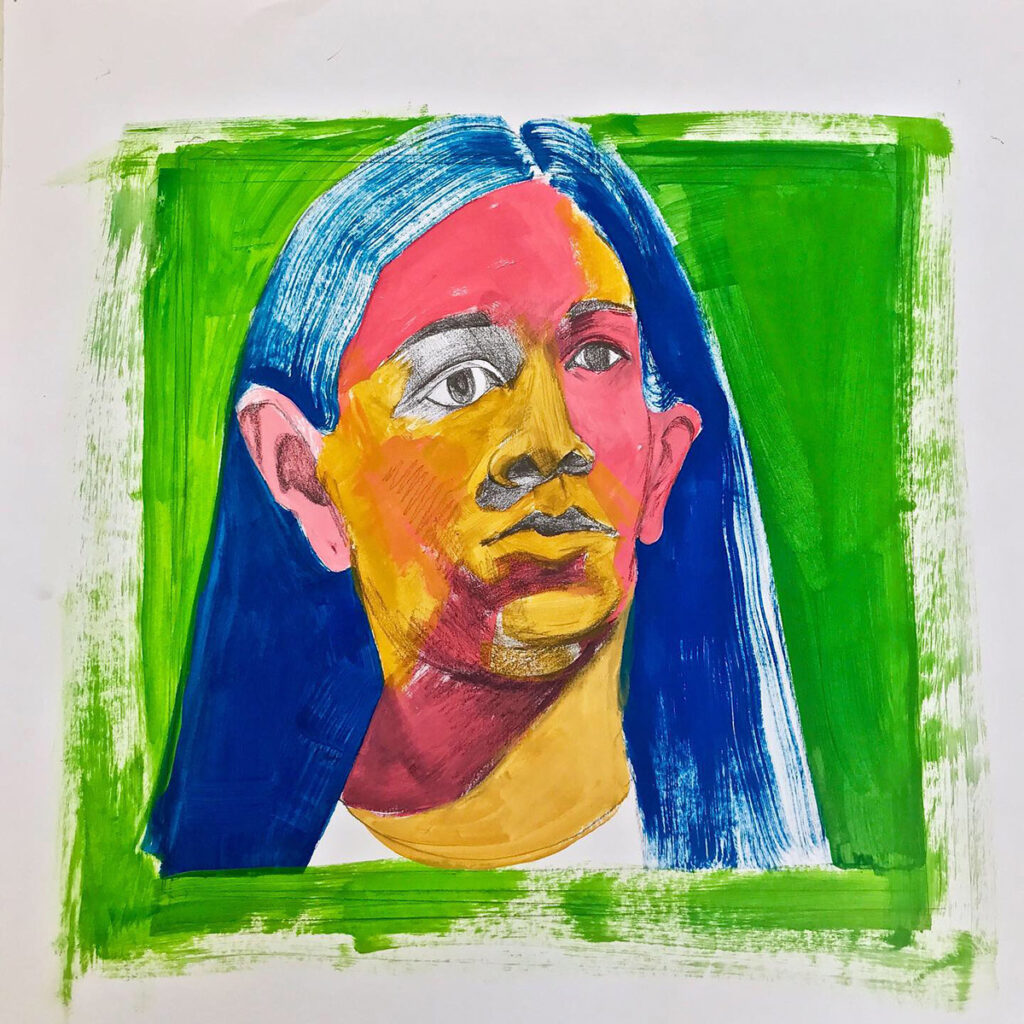
For the first time in many years, I have decided to return to self portraiture as a way to directly interrogate the lens through which I encounter the world. In my recent body of self portraits, I am not concerned with recreating an exact likeness of myself, rather I rely on my mirror image as a starting point in which I experiment with visual deconstruction, distortion, and disassociation. Socially, we are all expected to appear “put together” on the exterior, even if we are internally unravelling. Keeping up with appearances is exhausting— my self portraits struggle to do so.
My recent work is largely about coming to terms with how depression, anxiety, and addiction shape me, my experiences, my relationship with myself and physical environment—how these aspects of my consciousness color the lens through which I experience daily life. Somewhat in the tradition of Phillip Guston, the canvas is a place where I point the finger at myself before I point it at the world, and question how I contribute to or benefit from various aspects of society that I also condemn, such as materialism and consumerism. The process is one where I sift through myself in an attempt to remove the parts that cause self-doubt, endless worry about the future, and ultimately a frantic state of mind that I attempt to numb through endless consumption. Furthermore, through abstracting, distorting, and therefor disassociating from my self portraits, I am thinking about society’s obsession with physical appearances, how the coding of film, television, and pop culture imagery have shaped how I have come to understand and (de)value my sense of self, internally and externally. Ultimately, my portraits are attempts to simultaneously combine and break apart the connection/disconnection between my outward and inward lives, expressions, feelings, and realities.
Chantel Gushue
Massachusetts College of Art & Design, BFA
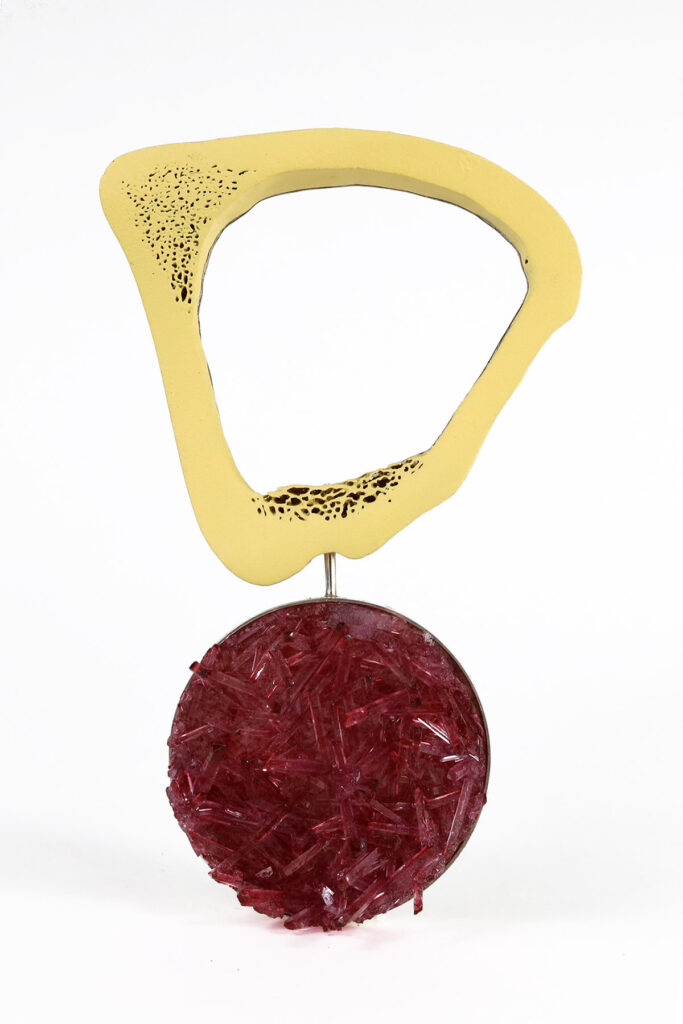
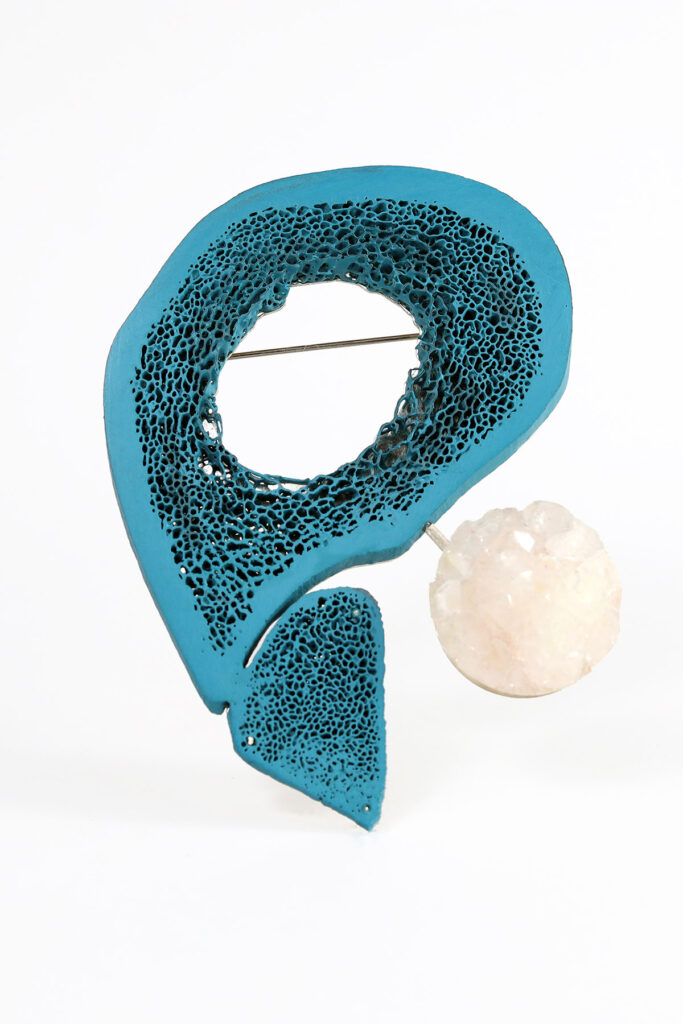
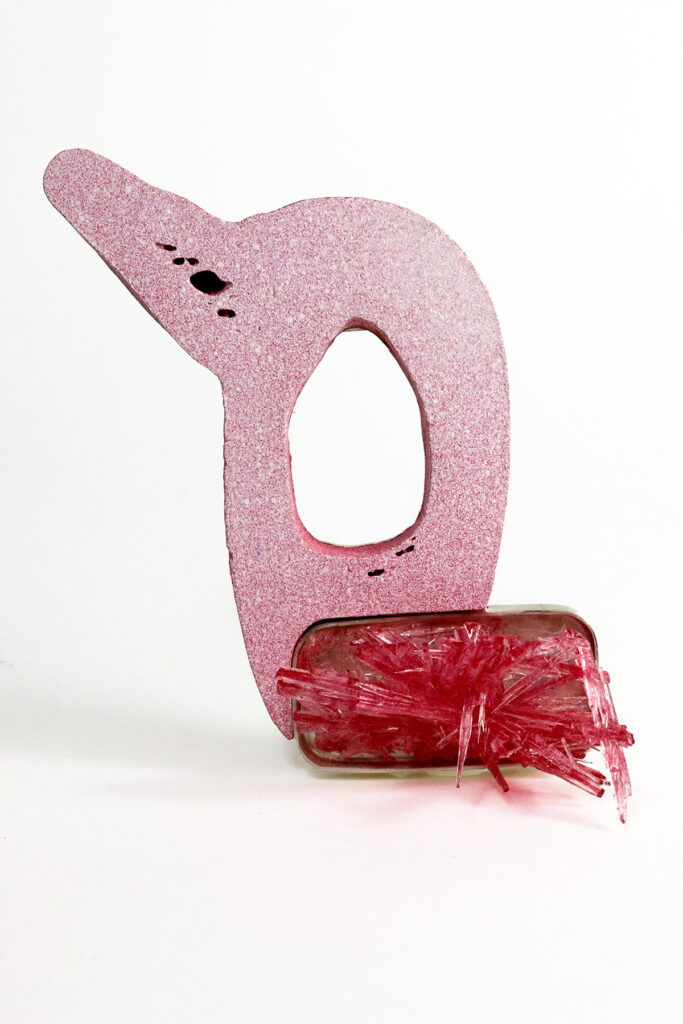
A crystal growing in nature relies on ideal, external conditions to allow it to reach its full potential. Any change in those conditions results in a crystal that is malformed and full of deficiencies. Ideal conditions are rare and finding the necessary chemical elements present to produce a crystal is uncommon.
In this series, I am juxtaposing bone and me-made crystals to create a conversation between the actual and the desired. Both substances are crystalline and will remain with us after other systems fail.
Chelsey Becker
School of the Museum of Fine Arts at Tufts University, MFA
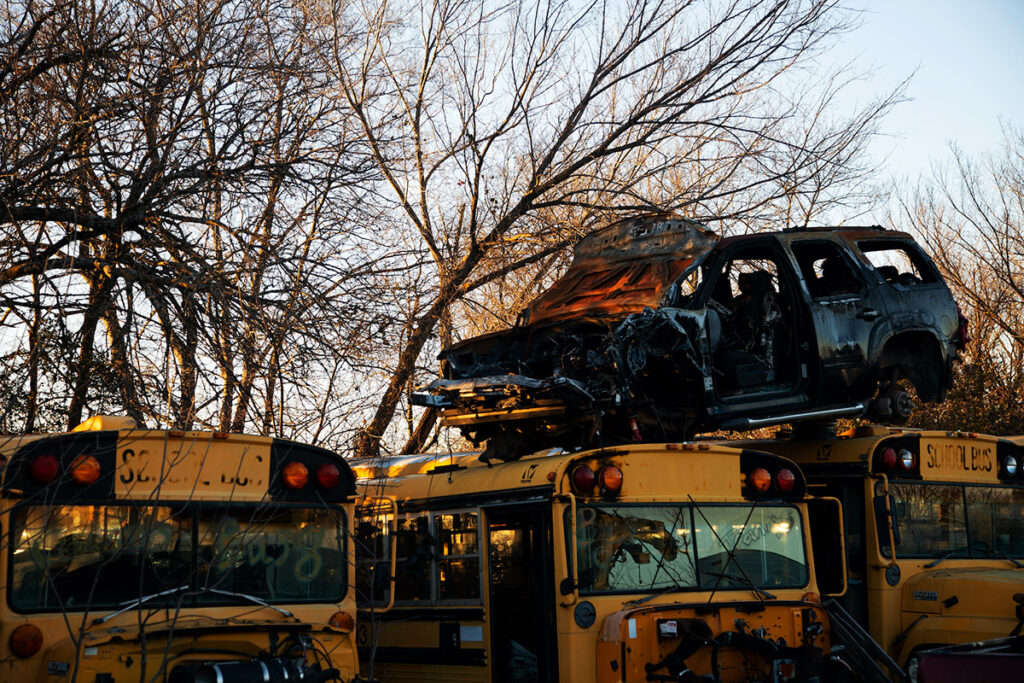
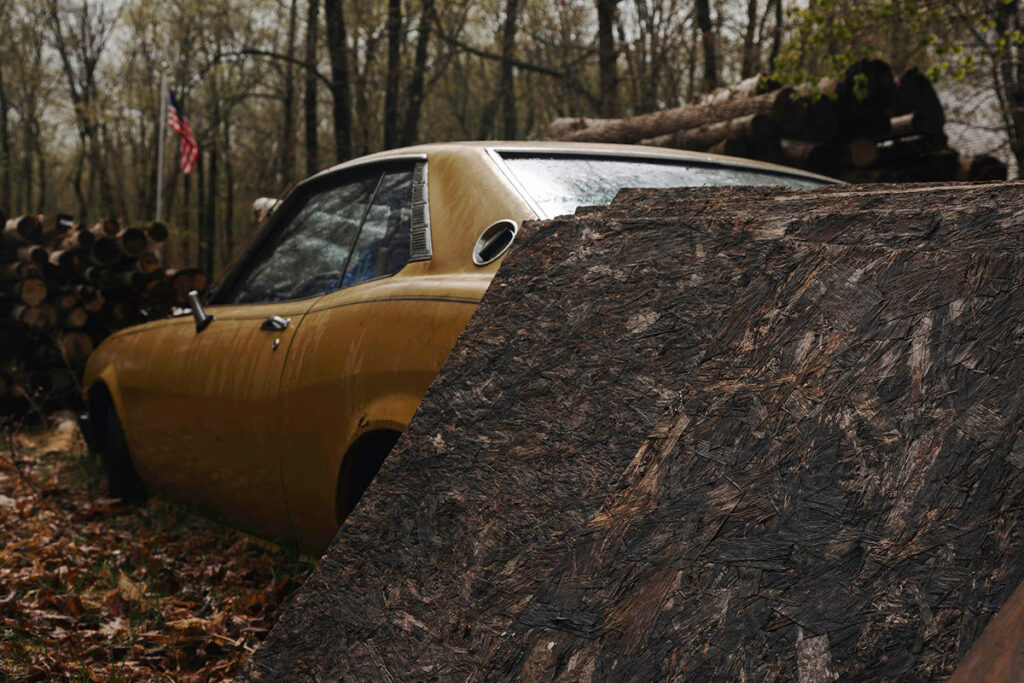
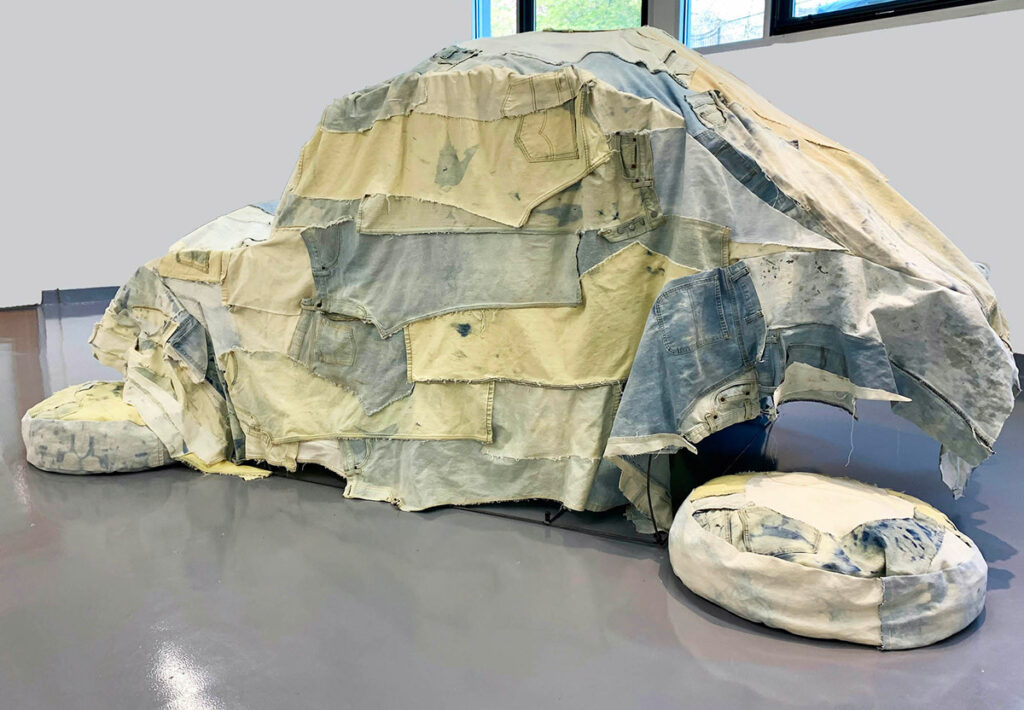
When contemplating the life of my late father, I imagine myself in an auto salvage yard sifting through the wrecked or totaled cars he used to drive, probing them for traces of him. After my father died in a car accident, as his sole beneficiary, I inherited everything he had, including a classic car that does not run. Within an artist book, I am chronicling my pursuit of my father through these items and the cars that he travelled in. With myself as the narrator, I am retelling his story while recounting the cross-continental road trip I embarked on to the multiple places he lived throughout his life. Along with this project, I am sculpting flawed effigies of components from his vehicles. I use materials reminiscent of labor and craft, like sewn blue jeans and carved wood, to explore the deep complexity of existence because, like automobiles, there are multiple parts that contribute to functionality.
Throughout his life, the cars my father drove symbolized pivotal moments that altered his path. They have become the vessels through which I have tried to understand him – not just as my father but as a person containing multiple facets of human character, both good and bad. Within the life of my dad, there was a roughhewn vernacular that spoke of blue-collar labor, crisis, loss, and individuality. These aspects relate to the craft of car restoration and rural human geography in a world that is increasingly losing its accessibility to tactile pursuits due to advances in technology. Because my drive to understand my father is now interwoven in his own narrative, larger questions are raised in my work regarding how we relate to one another, how we exist in the world, what inheritance means, and what happens to memory.
Devin Wilson
Brown University, BFA
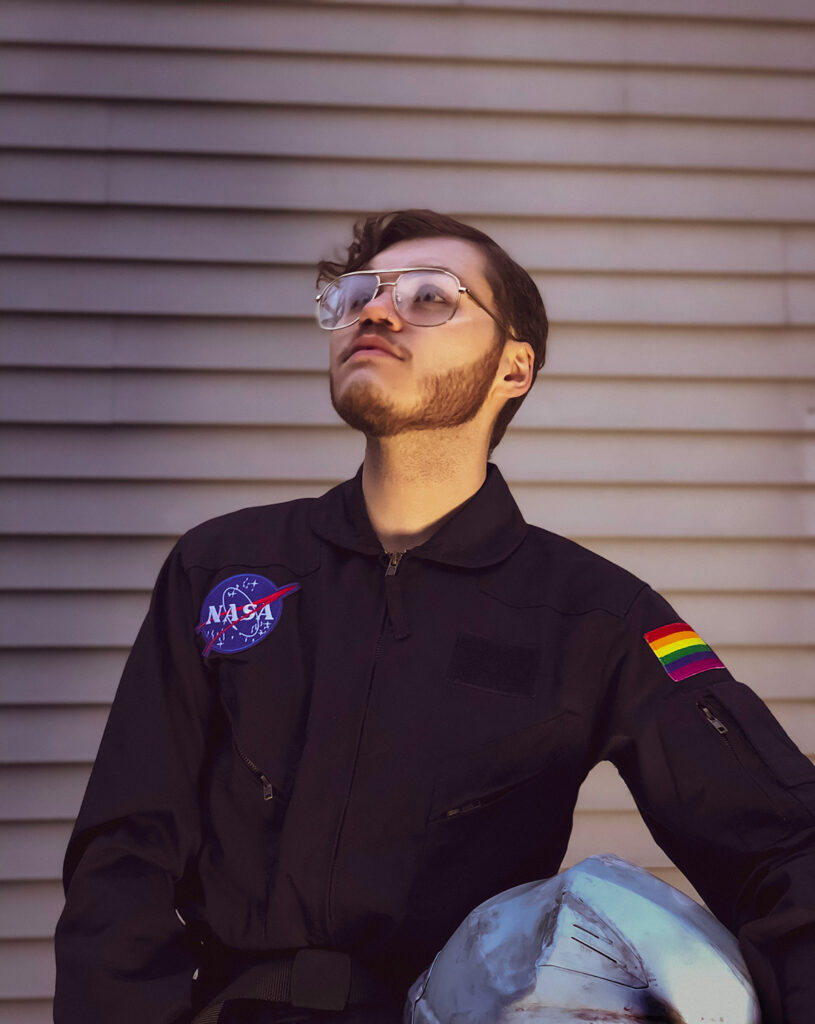

As an activist and political artist, my work addresses sociological issues related to gender and queer identities. I explore the stereotypes and expectations of queer presenting people within oppressive heteronormative culture. My work reinserts my community and my identity into systems, spaces, images, and relationships within the broader society that often deny my community’s various identities. My process as an artist is about queering, or “ to queer,” a verb that originates from queer theory and the term “queer reading.” This term is used to challenge normative culture and subvert heterosexual binaries. With the act of queering, my work ‘represents’ the world through a queer lens.”Queering is something we do, rather than something we are (or are not).” This process often uses queer-adapted vernacular “references“ to offer a platform of familiarity to a queer viewership. These references are derived from history, theory, and media. Queer specific references constitute a secondary language and an alternate social iconography used within queer culture. Elements of camp, such as artifice and exaggeration, also play a large role in my work, as they allow those positioned outside of the queer community to connect through its humor and formal exaggeration. I believe that art should be accessible to all populations, and by using these elements, I strive to create dialogue around issues facing the queer community both within ourselves and beyond. Currently, I am a senior BFA sculpture candidate at Boston University, College of Fine Arts.
Drew Dodge
Rhode Island School of Design, BFA
Drew Dodge is an interdisciplinary American artist working in video, sculpture, and painting. He investigates digital intimacy, sexuality, and memory as he combines romanticized digital realms with physical objects, exploring the sensitivities of the human body. He obscures communication and studies online sociality by extruding beloved internet scatological detritus from the bowels of internet timelines into the eyes of his audience. His work is rooted in naive internet experiences, childhood desires, cultural production, prank, and the plasticity of genericized consumerism.
Julian Parikh
Brown University, MFA
I needed proof. I had thirteen voice recordings in front of me, dropped into some audio software. I now had a visual representation of my voice recorded almost every two weeks since I started taking testosterone, and evidence of a change …somewhere. Somewhere in these bright colors and varying lines was solid proof that my voice had gotten lower. The problem was, I couldn’t figure it out.
I asked a friend who knew more about sound and audio and got some advice on how to look at the data the software was showing. I played with it for hours but I still couldn’t figure it out. This program, that was supposed to give me confirmation of something I thought I could hear, was just a blur of beautiful, meaningless colors. But just because I couldn’t find meaning in it doesn’t mean there wasn’t any.
I rubbed testosterone gel on my arms for eight months straight. I read Joy Ladin’s words over and over again, for eight months straight. Each time I recited the poem, the recordings always ended just short of one minute. What followed, was a compression of eight months of time, experiences, feelings, and changes, in one single minute.
Karli Tucker
School of the Museum of Fine Art at Tufts University, MFA

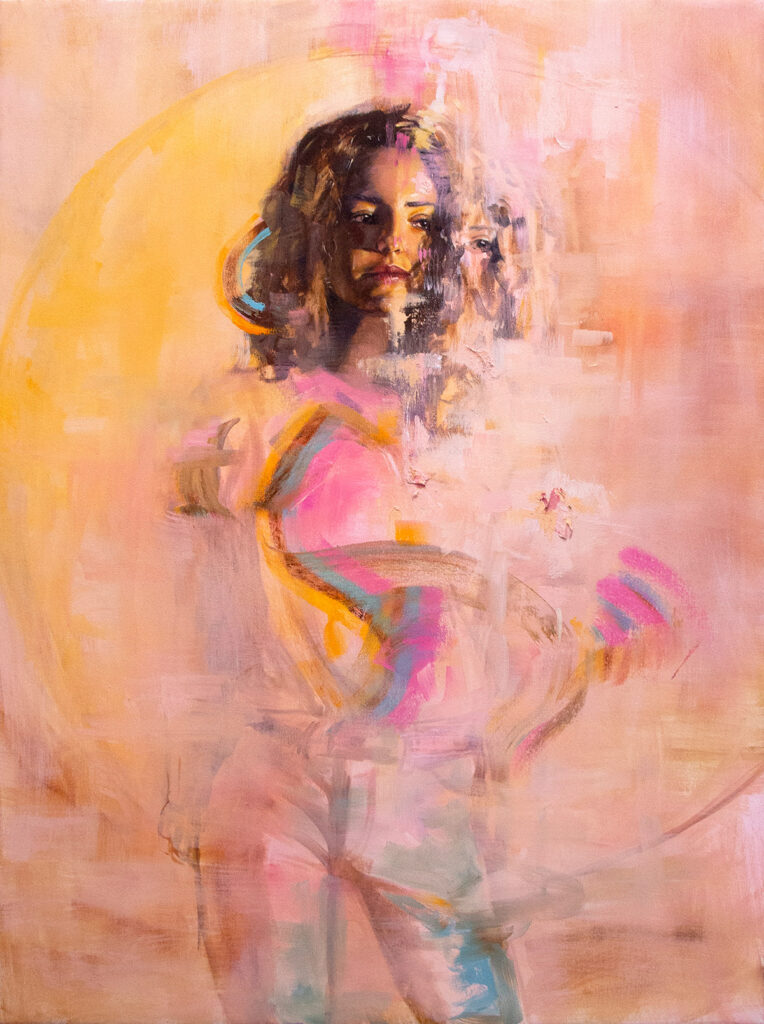
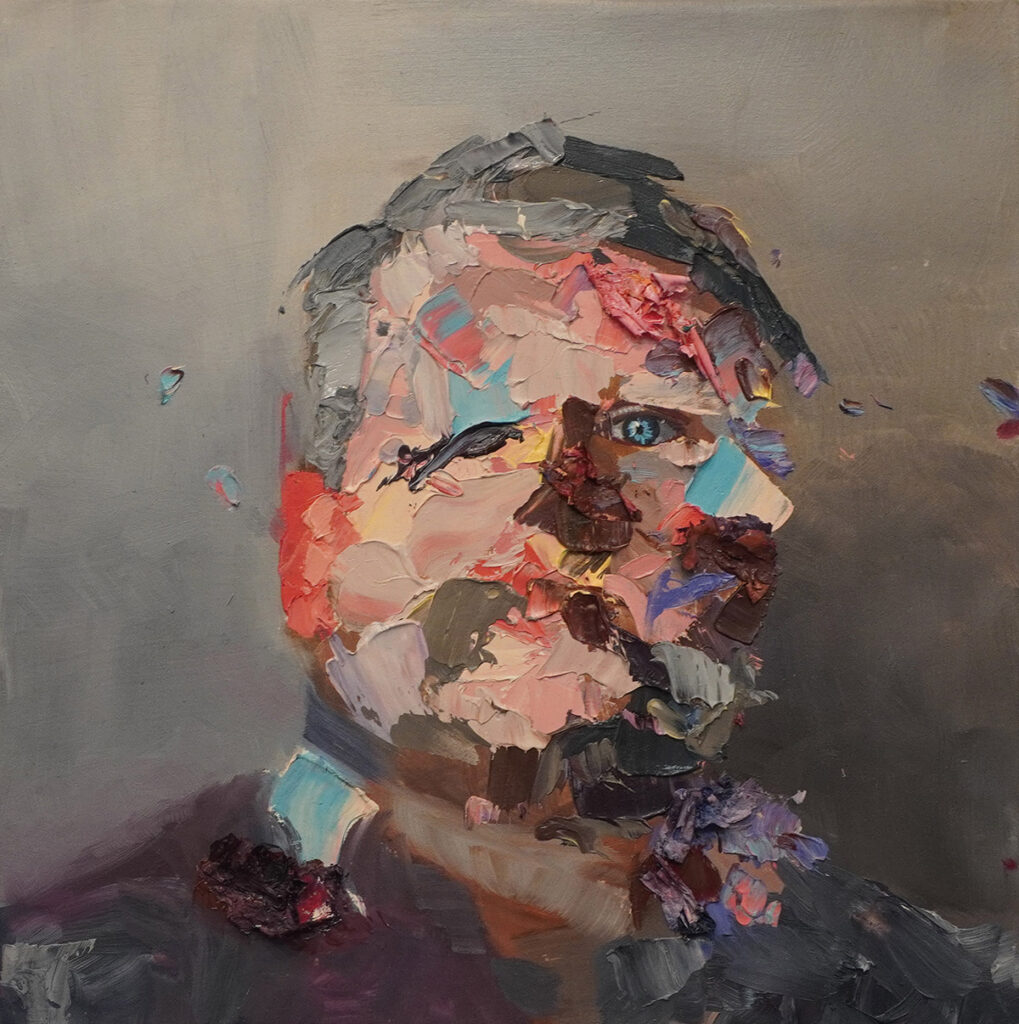
I am a classically trained painter and multidisciplinary artist. There’s a confidence in the skill of portraiture in my work and a joy in the sculpture and installation. Exploring the relationship between trauma and identity through transposing portraiture onto unstable or anamorphic media gives me a way to create a physical representation of memory loss, hallucinatory states, body integrity, and dissociative episodes. I spend time investigating alienation from myself in response to physical and psychological phenomena. I think about how I am and am not myself. I am in search of the processes and rituals we explore to mend the psyche and grow out of trauma-response living into a productive present reality. Originally from Southern California, I am heavily influenced by the cultural patois and palette of the West Coast. Spanning from the sprawling neon and smog-diffused coastal energy of Los Angeles to the austere warmth of the desert interior, the region is ingrained in the work I create. I look for the beautiful amongst the harsh realities of life, and my work reflects a desire to find solace and healing in the sublime. I strive to speak truth and the power of optimism through my art in a sea of anxiety- invoking scenes of extraterrestrial landscapes, cancerous growth, funhouse mirrors, and claustrophobic spaces.
Laia Sancho-Rosi
Smith College, BA
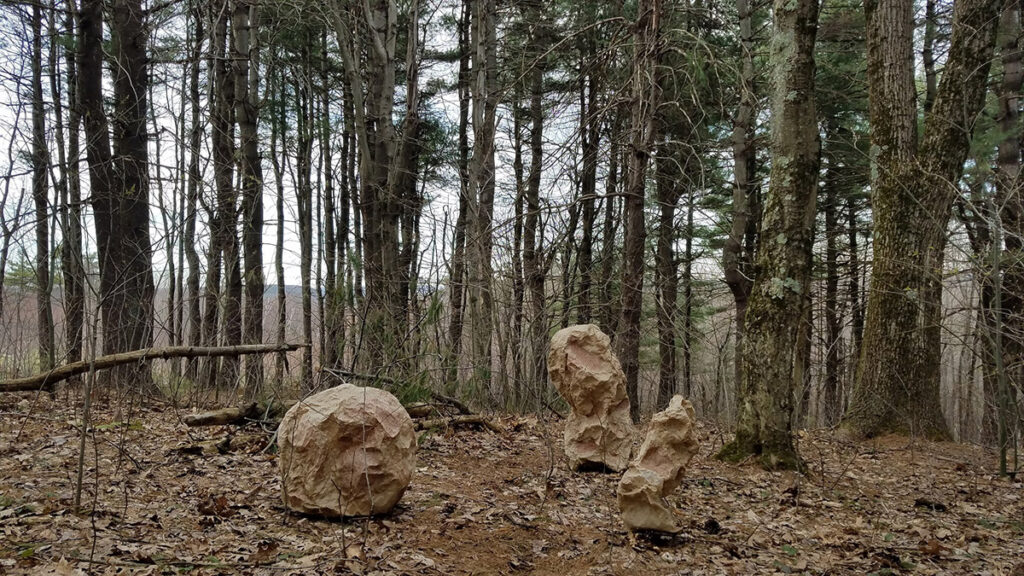
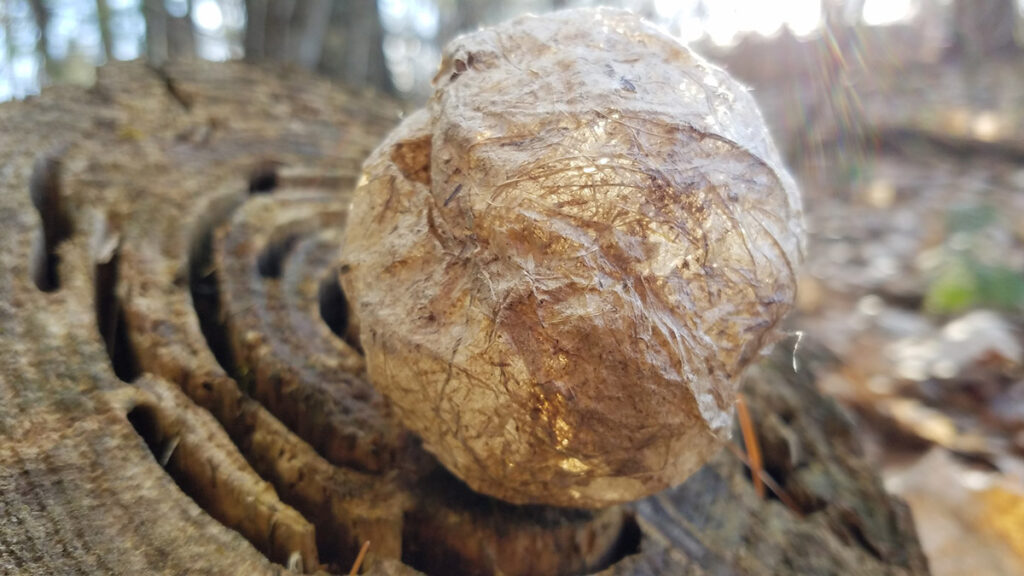
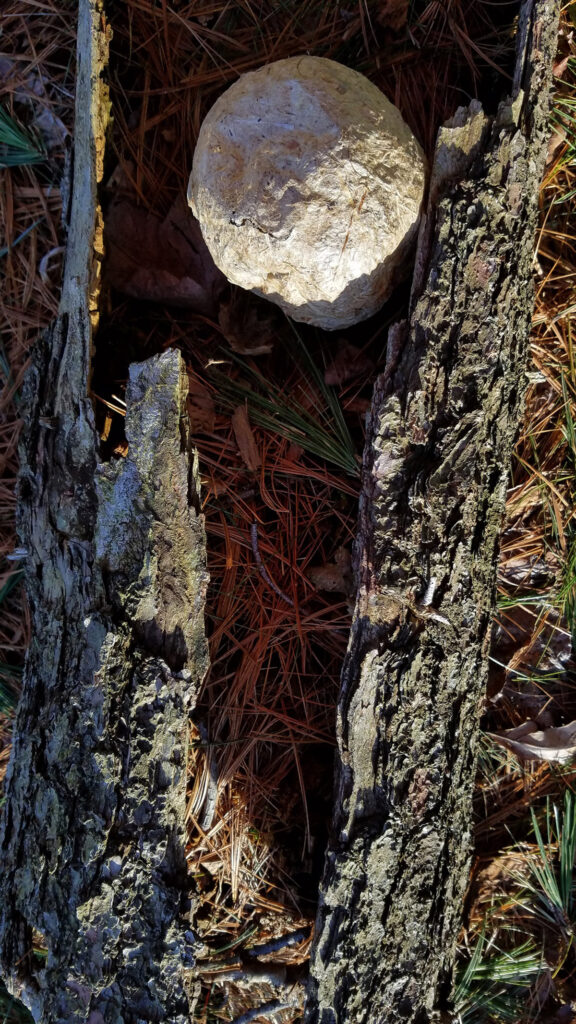
This project is made from foraged natural materials entirely found in my immediate environment. Through the different qualities of the patchwork of my handmade paper, and its close resemblance to rocks, I have explored themes of place and belonging (or lack thereof). Two words relating to rock formations and arrangements have informed my thinking: “cairn” and “erratic.” A cairn is a pile of stones arranged either as a method of navigation and orientation in nature (especially on hiking trails) or as a memorial or gravesite. Cairns symbolize the interaction between humans and nature that has existed for thousands of years. The word erratic, in geological terms, is a stray mass of rock foreign to the rock surrounding it that has been moved from its original site, such as through glacial activity: a “glacial-borne” erratic. In other contexts, erratic can mean irregular, unpredictable, wandering, or nomadic.
When I first began this project, I was primarily concerned with the objects as sculptural forms and I tried to address questions of craft, material, authorship, and interaction. However, in this new reality of social distancing, I have shifted my focus to broader questions about embeddedness, dislocation, and intervention within the environment. I am interested in the tension that arises from these ambiguous forms mimicking natural, found forms (like seed pods, nests, cocoons) yet simultaneously being entirely handmade through the intensive process of papermaking. Paper holds imprints of any action upon it; a crease or fold can never be erased, much like human action on the landscapes we inhabit. It is my hope that the fragility of these forms, despite their seeming permanence, reminds us of the fleeting, ephemeral moments in nature that we may only glimpse before they disappear.
Marla McLeod
School of the Museum of Fine Arts at Tufts University, MFA

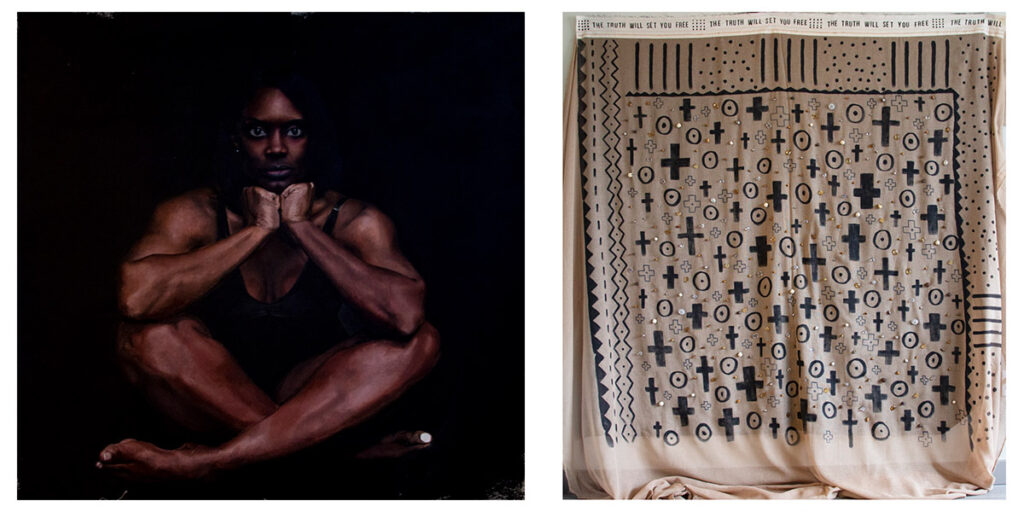
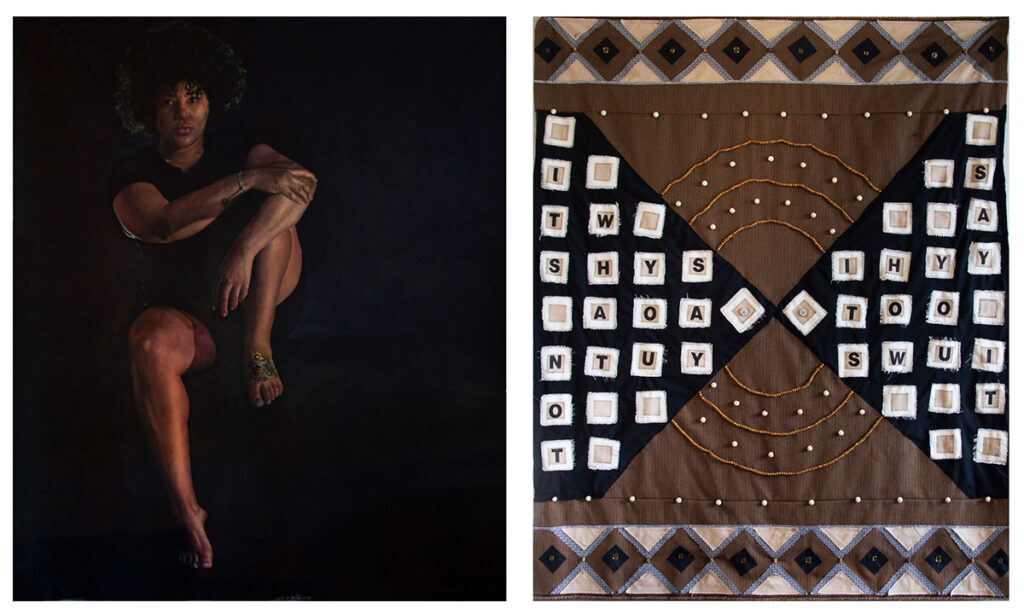
I create works that provide social commentary about how history and race have impacted the power of the black body. My work unites symbolic and historical imagery, and ideas found within the Euro-American canon and is influenced by the dynamism and challenges associated with the black body in contemporary culture. By emphasizing symbols of pride found in black American culture, I combat false narratives and explore new ones.
My oil paintings highlight associations of social value by taking advantage of a medium from which black women have been nearly exempt historically and even more infrequently found as the focal subject. I render my subjects monumental, and skillfully paint that which represents them in American society; their skin, hair, and physical features. The paintings deny ideas of expected submission, anonymity, and invisibility by this group of women.
The paintings are diptychs, paired with cloths created using symbols, and references to the customs associated with Mali mud cloths. My cloths, like the traditional Mali textiles have been created as symbols of protection, and also represent the African diaspora, pride, and culture. Each is created by piecing together elements such as; textiles, faux jewels, wood beads, buttons, and painted and/or sewn cloth. Lessons from the mothers of the women are inscribed on the cloth using beading, and painting and reflect the Dominican, Southern African American, and Jamaican cultures of the painted subjects. The cloths expose the differences within black cultures which are often overlooked in generalized representations of black people in America.
Through the work I call for the attention of and understanding from the viewer and to have them accept a creatively defined view of black culture which distances our image from the traditional negative imagery associated with the black body.
Mia Fabrizio
School of the Museum of Fine Arts at Tufts University, MFA
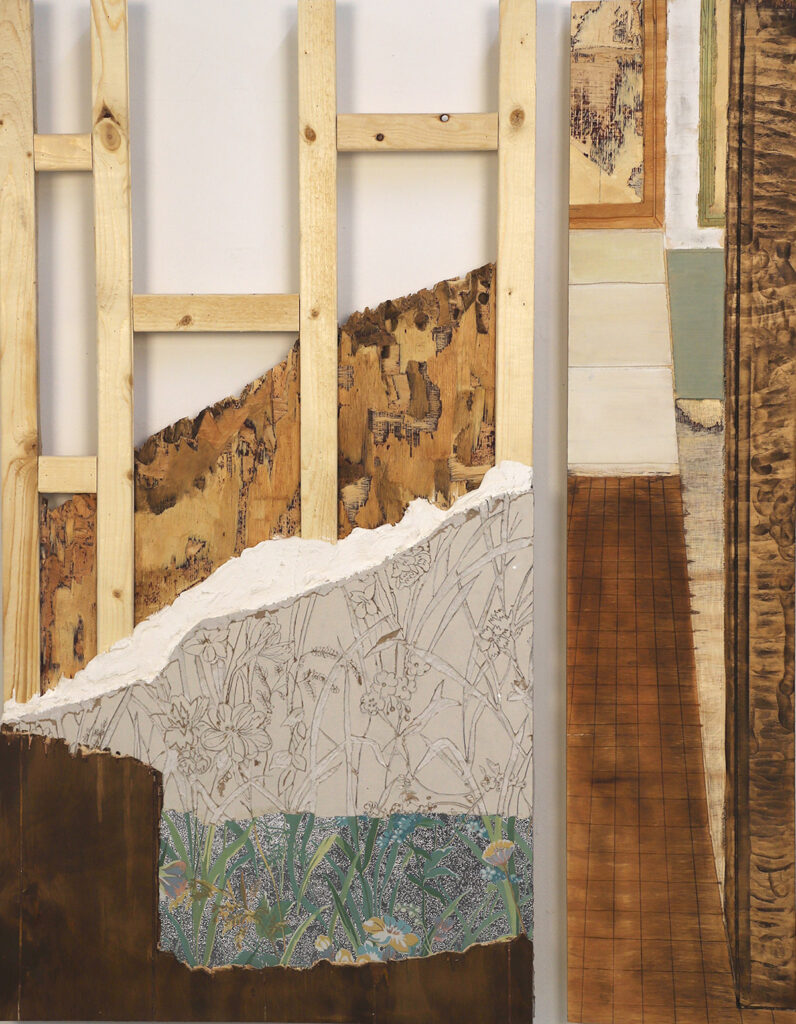
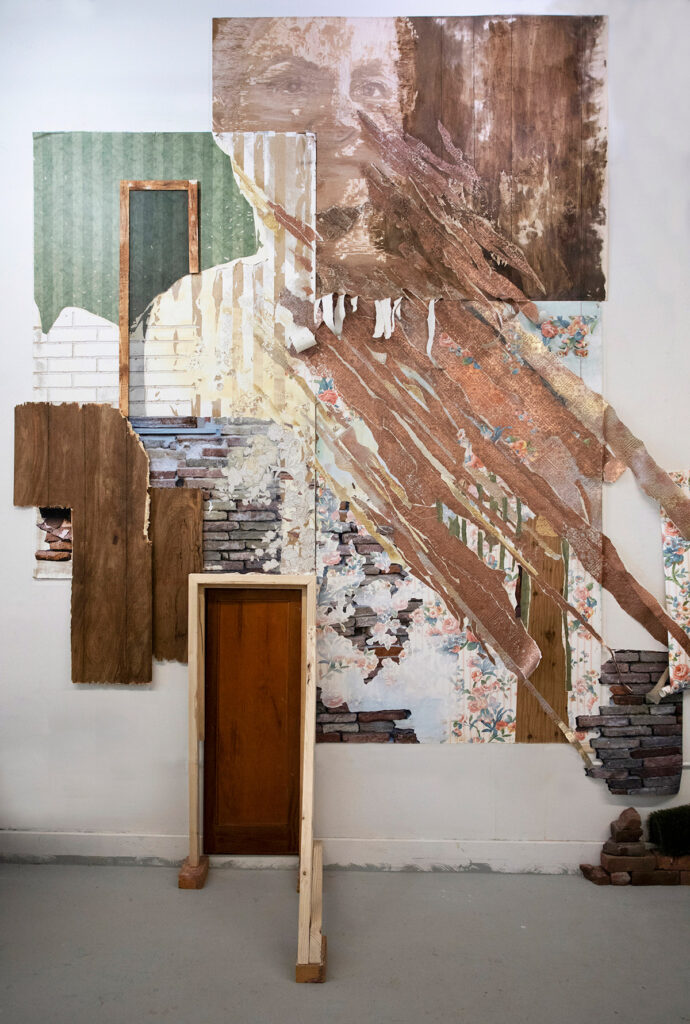
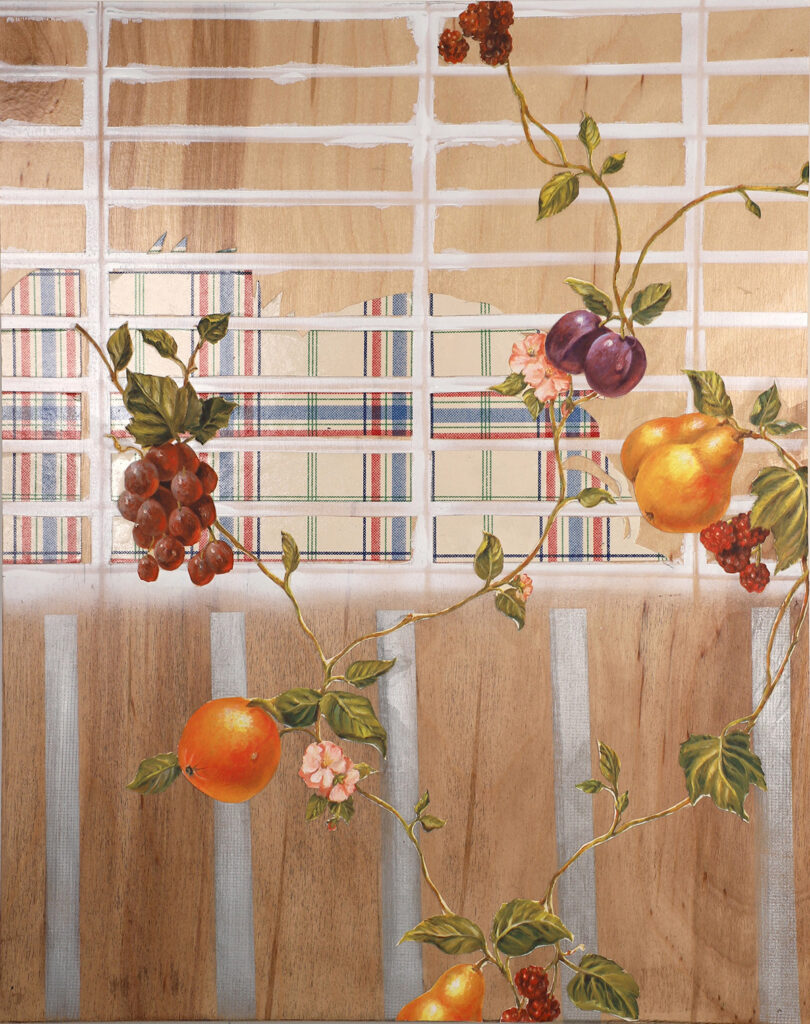
Our family home is 15 miles outside of Philadelphia’s center, in a former steel mill town where European immigrants of the early 1900s settled. In the mid 1950s my Italian-American grandfather remodeled this 3- story family house into a multi-use structure that serves as home and a family-run business. The smells of perm solution and fresh tomato gravy have mingled for four generations. Still today, only 3 steps separate the handcrafted hair salon from our kitchen table.
I am consumed with hidden and exposed structure, both architectural and social. My investigation of physical construction, cultural constructs and their relationship originates from the framework most familiar to me, the house in which I grew up.
I merge painting, collage, printmaking, sculpture and installation to create two and three-dimensional artwork that deconstructs and recreates this space. There is an emphasis on memory as I adhere, carve and chip away at wallpaper, plywood, drywall, paneling and objects. Patterns are interrupted and fall apart.
Through materiality and process a sense of fluidity between feminine and masculine, public and private and modern and traditional is relayed. The physical layering of materials alludes to the emblematic layers of people and to the layers that comprise the immigrant culture over time. The work is a map of comprehension. By peeling away the facades and breaking the constructs my intention is to question the systems that are accepted and perpetuated as normal, cast away the prescribed and free the spirit of the individual.
Micaela Nee
Brandeis University, BA
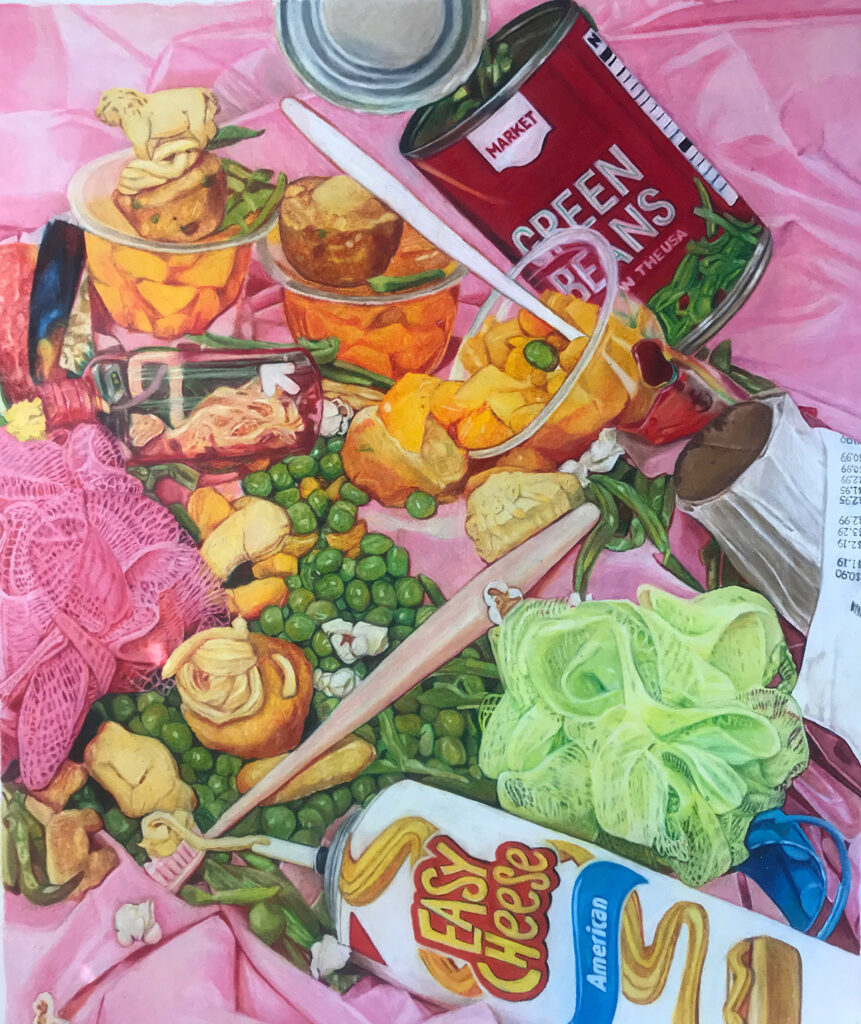

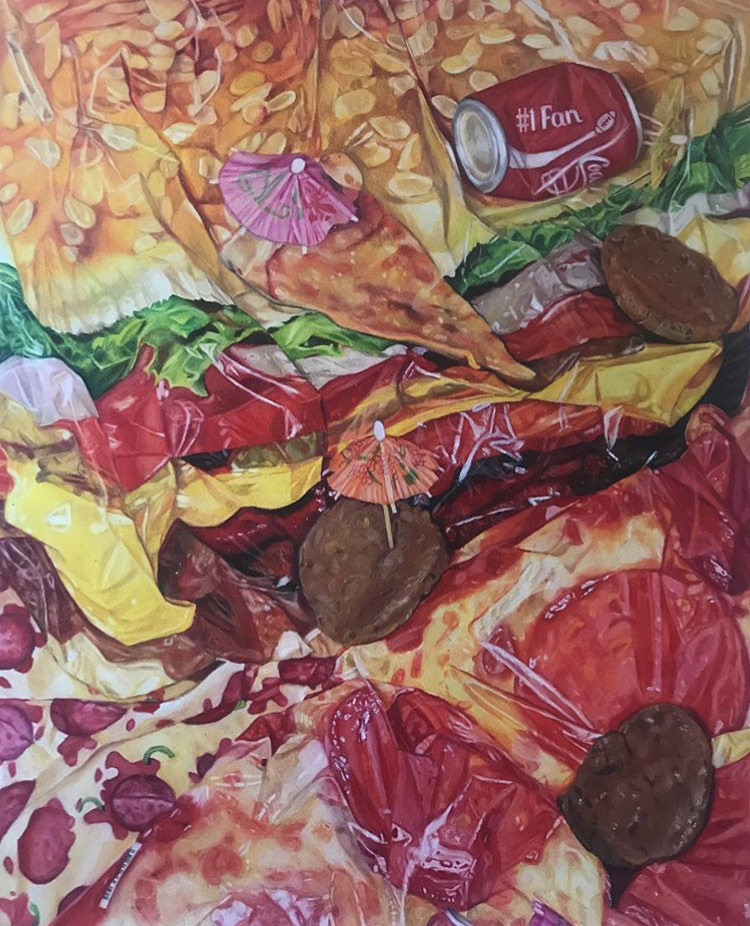
My work explores American ideals of abundance and preservation through consumer culture. Mainly the work explores excess in American food culture. Using still-lives, I create absurd displays using food products. I like exaggerating the vibrant, visceral surfaces of Americana food, such as greasy pizza, mac & cheese, and burgers.
Through the process of my work, I am participating in the role of the American consumer. I purchase items from the store, and the products then become still-life objects, which turn into photographs, then paintings or drawings. I am interested in how the repetition of my process emulates advertising. The removal of levels from the original source material moves it further into the realm of artifice.
The absurd food displays reference pop art, food photography, and advertising imagery. I am critiquing ideas of nationalism that are present in the production, promotion, and packaging of food. Similar to the visual stimulation and bombardment elicited through advertising, I overwhelm the viewer through the hyper-details and ‘supersized’ scale. My work confuses the viewer by simultaneously celebrating and vilifying the imagery and moving between artificiality and reality. I am interested in the concurrent threads of celebration and critique. I want my work to be enticing and repulsive at the same time. The work emphasizes the grotesqueness of classic American foods, while challenging patriotism, domination, and consumption.
During COVID-19, the issues in my work, circulating stockpiling, preserved foods, and the division of resources, are even more prevalent. I invert the notion in pop-art that nothing lies beneath the surface. With nostalgia and preservatives pumped into American food, there is a psychological and legitimate enduring presence to these foods. I see my work using depth to question what lies beneath the shiny grease and glistening processed cheese.
Moriah Faith
Lesley University, BFA
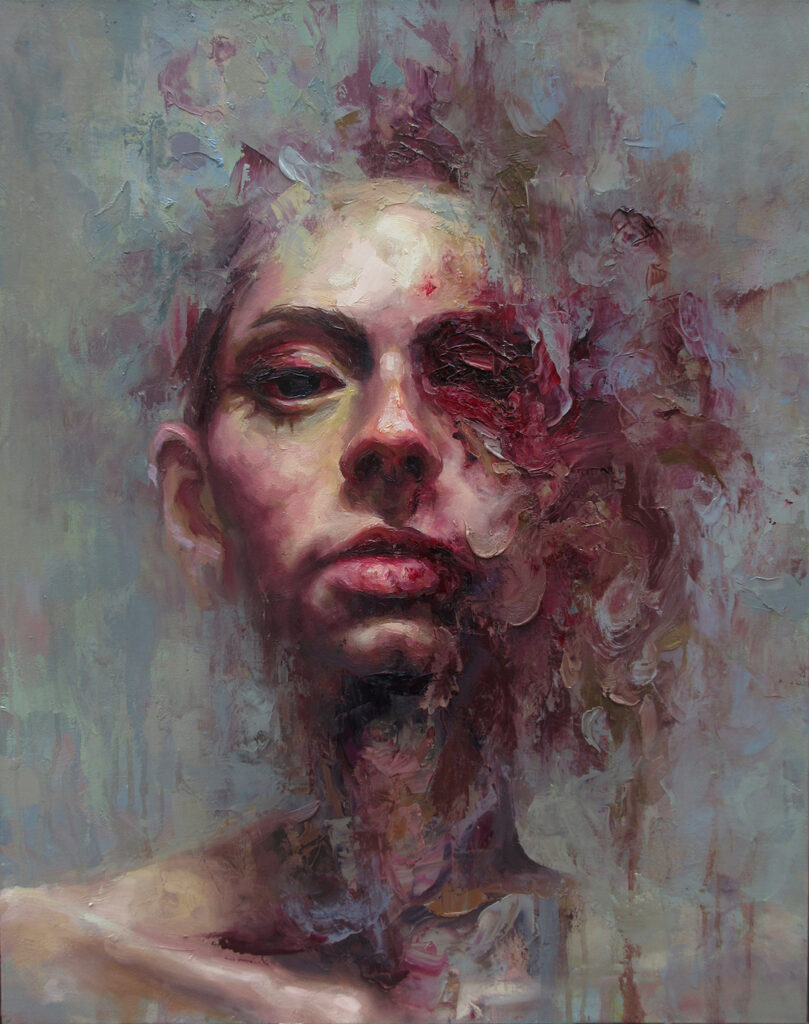
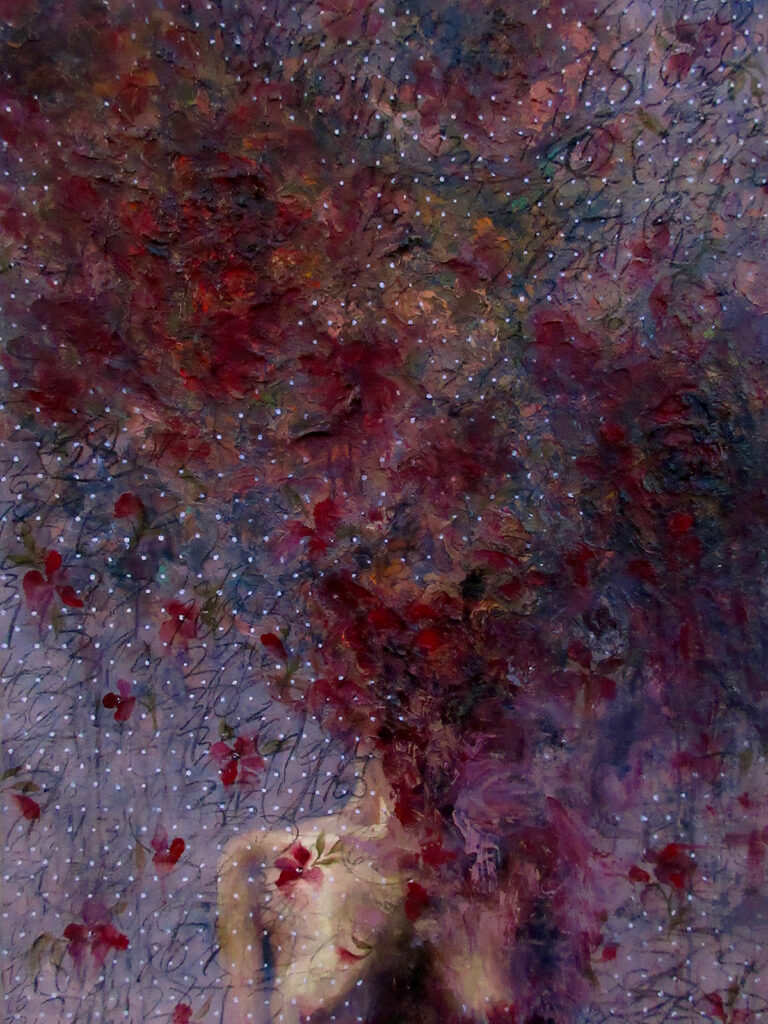
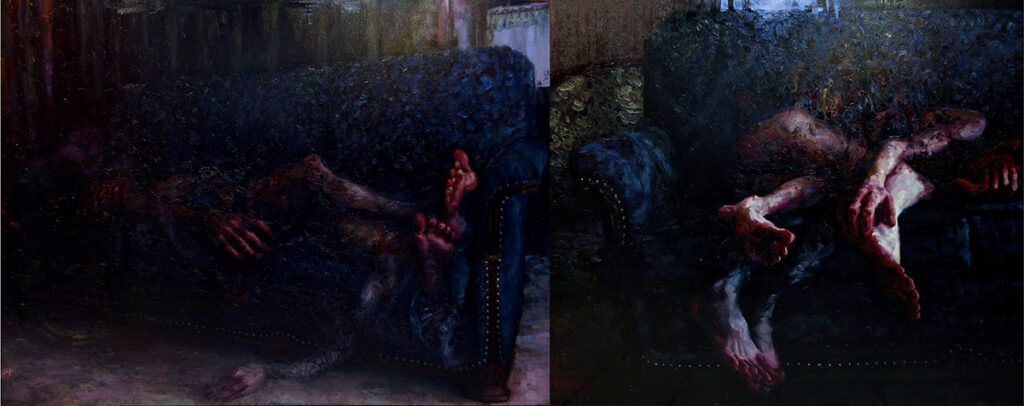
Existing within myself became excruciating when I was diagnosed with a rare chronic illness in 2011. At thirteen, I mourned the death of the vibrant and healthy person I was before I got sick. Out of this dark period, I started to paint. My most recent series, Times I Wanted to Disappear, is inspired largely from my experience with an eating disorder since I was young. It manifested itself as a drive to keep getting smaller and smaller, until maybe I could disappear entirely. My paintings explore this drive and the point of conflict when the way in which I experience my body contradicts my sense of self.
I’m captivated by the aesthetics of the body: how flesh folds and shifts color in the sunlight, or how it changes color when exposed to trauma. I am obsessed with the complexity of our anatomy, the imperfection of skin and how it blossoms with color when it bruises or decomposes. We experience the world through our bodies, and I’m disturbed by what lies under the skin. I’m upset by my tendency towards violence against my own flesh but amazed by how my body carries and copes with trauma. Our bodies can bear such intense pain but also such intense beauty and that’s why I’m drawn to paint them.
I paint together my memories that come back in fractured images. My image in the mirror is equally fractured and distorted and that is how I paint it. My figures lay somewhere outside of reality, between evaporating and materializing. Most of my life I have spent fighting between wanting to disintegrate into nothing, but also wanting to create and be seen. I have taken these moments of intense emotion when I wanted to be small, and I have made them large.
Neetu Singhal
Massachusetts College of Art & Design, MFA
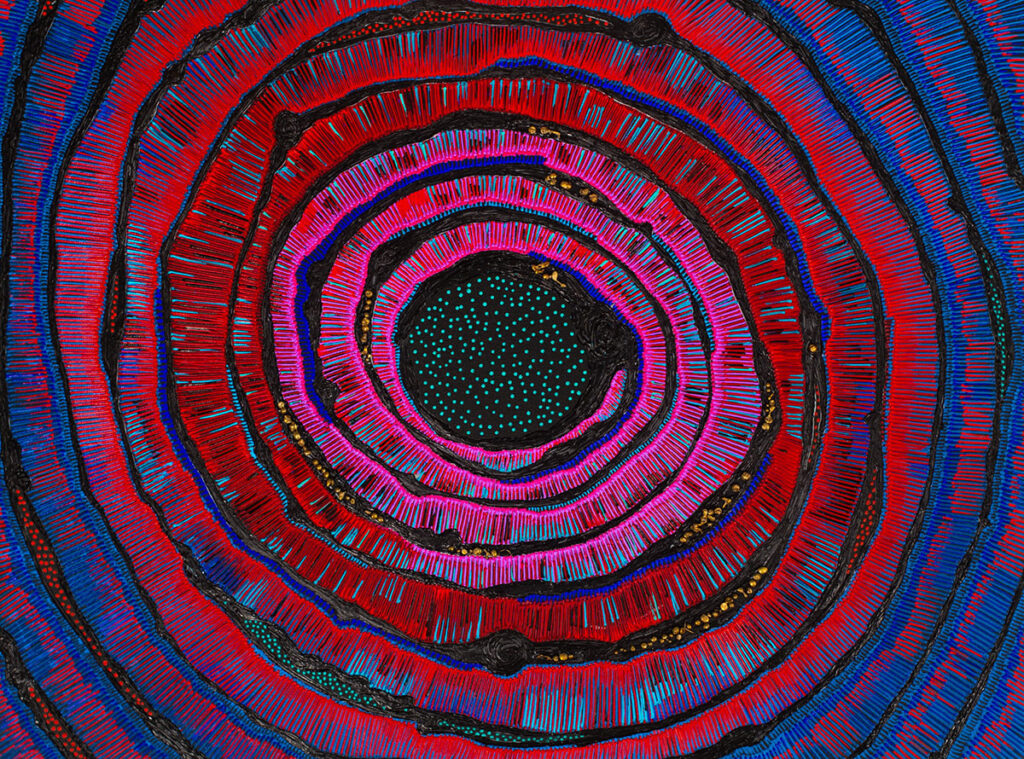


My artistic process begins with a desire to understand of “universal energy” in, how each of our consciousnesses explores visual forms. I experience this energy when my interaction with visual forms becomes conscious and evident. Two visual forms inhabit my work. Dots and lines appear in many of my works and evoke everything in the universe. Dots are atoms and cells and stars. Line is an infinity & the continuity of life. I believe that in this universe everything is made up of ‘Dots’’, and a ‘Line’’ is the extended form of ‘Dots’’ and also I am trying to observe the independent identity of dots and lines. I try to use all of my senses to observe and investigate these forms.
The interactions between dot, line, color, and pattern generates the energy I seek to understand and make visible. I experience a sense of vibration across the multidimensional surface during this process. I am very interested in the properties of the colors; viscosity & velocity, which provides tactile surface experience with so many aesthetic interpretations. Using light and sound helps to give these visual forms other modes of sensory stimulation. In my recent investigation & research I am interested in synesthesia and Cymatic-Telepresence I am fascinated in the correlation between science and art, particularly through my own experience and understanding of colors & forms- analysis in neuroscience.
Olivia James
Boston University, BFA
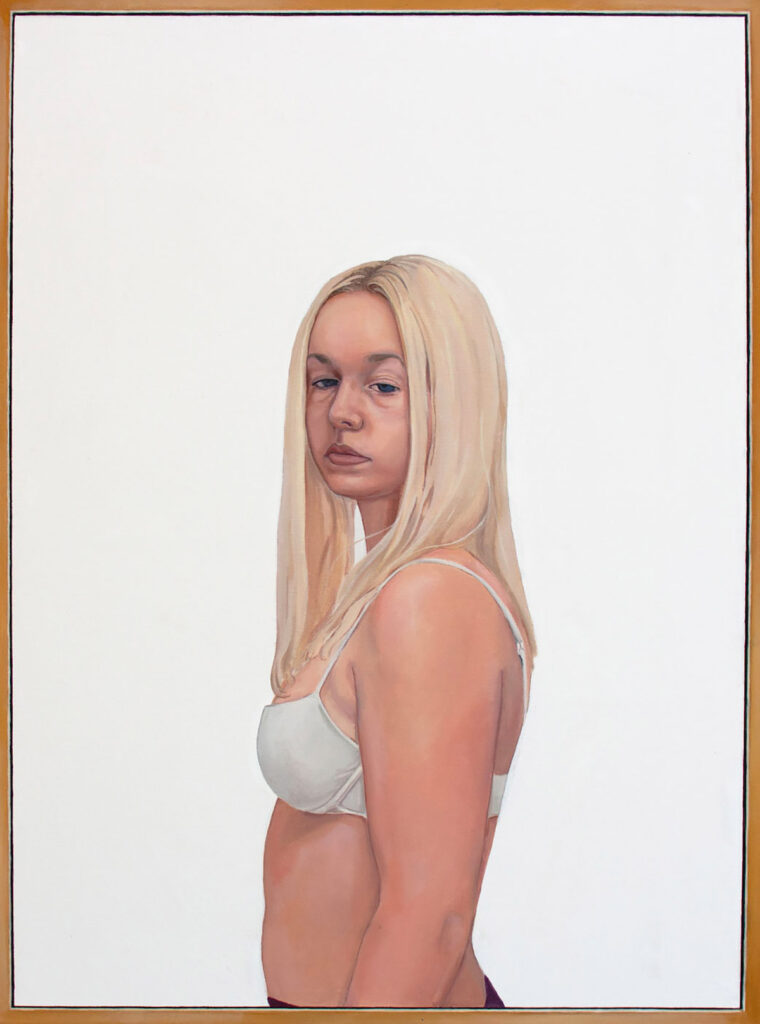
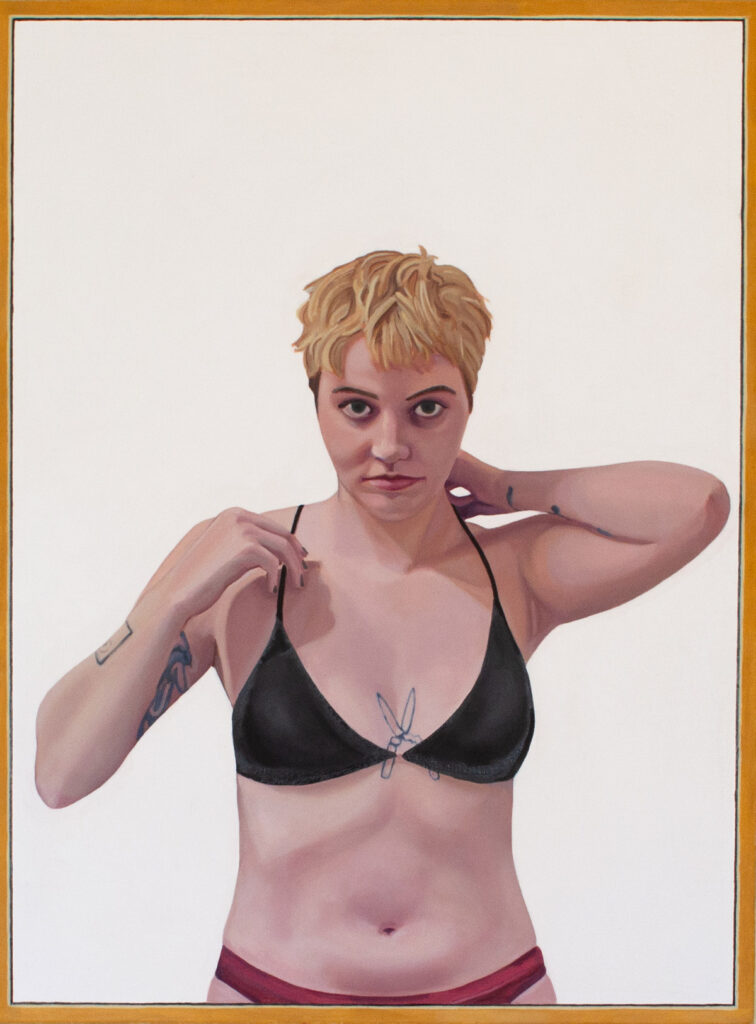
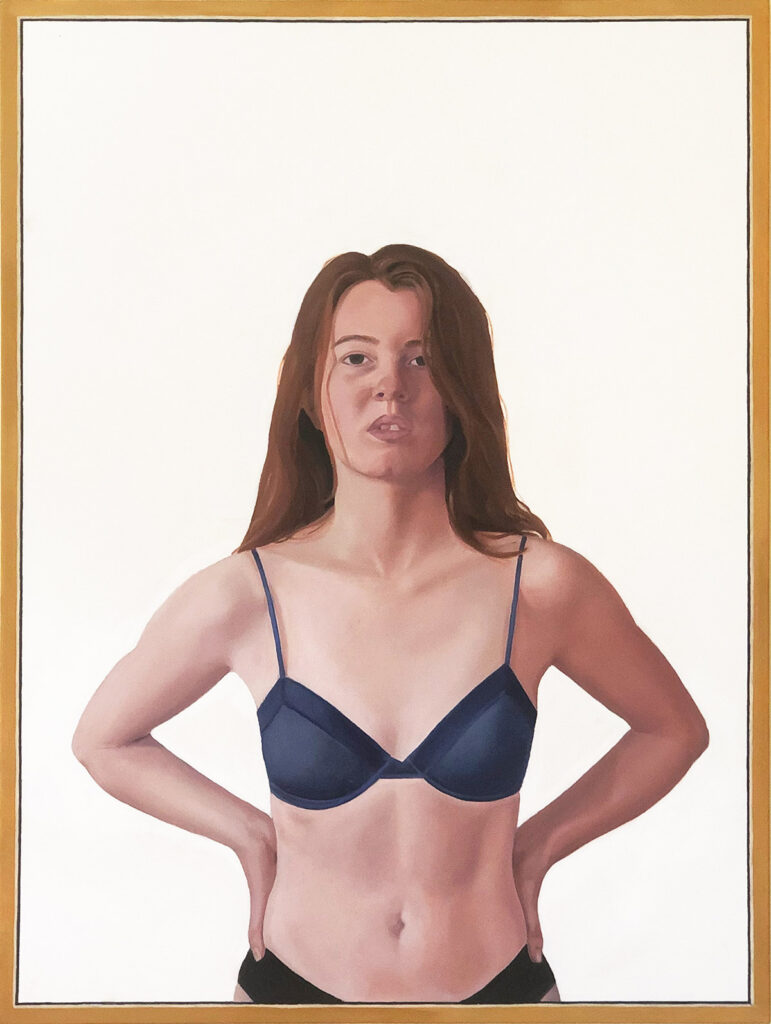
For this series of paintings I focused on female vulnerability through the gaze: the gaze of the figure looking at herself in the mirror — the female gaze on her own body, and the gaze of the viewer, looking at the figure. I wanted the paintings to have a sense of immediacy, so I put the frame on the edge of the canvas and made the figures almost life size. In addition, I tried to make the figures as realistic as possible, thinly layering the paint to produce lifelike forms. In these paintings, there is as much emphasis on what the viewer does not see as on what they do. The space around the figures is completely white, taking away the context of the room that they are in. In that way, I wanted the viewer to question what they are looking at, while placing all of their attention on the figure in front of them. The figures are not imbued with any explicit meaning, rather they allow the viewer to project meaning because of their accessibility. They stand facing the viewer in a position of open vulnerability, inviting them in, or rather, unable to keep them out.
Scott Lerner
Brandeis University, MA
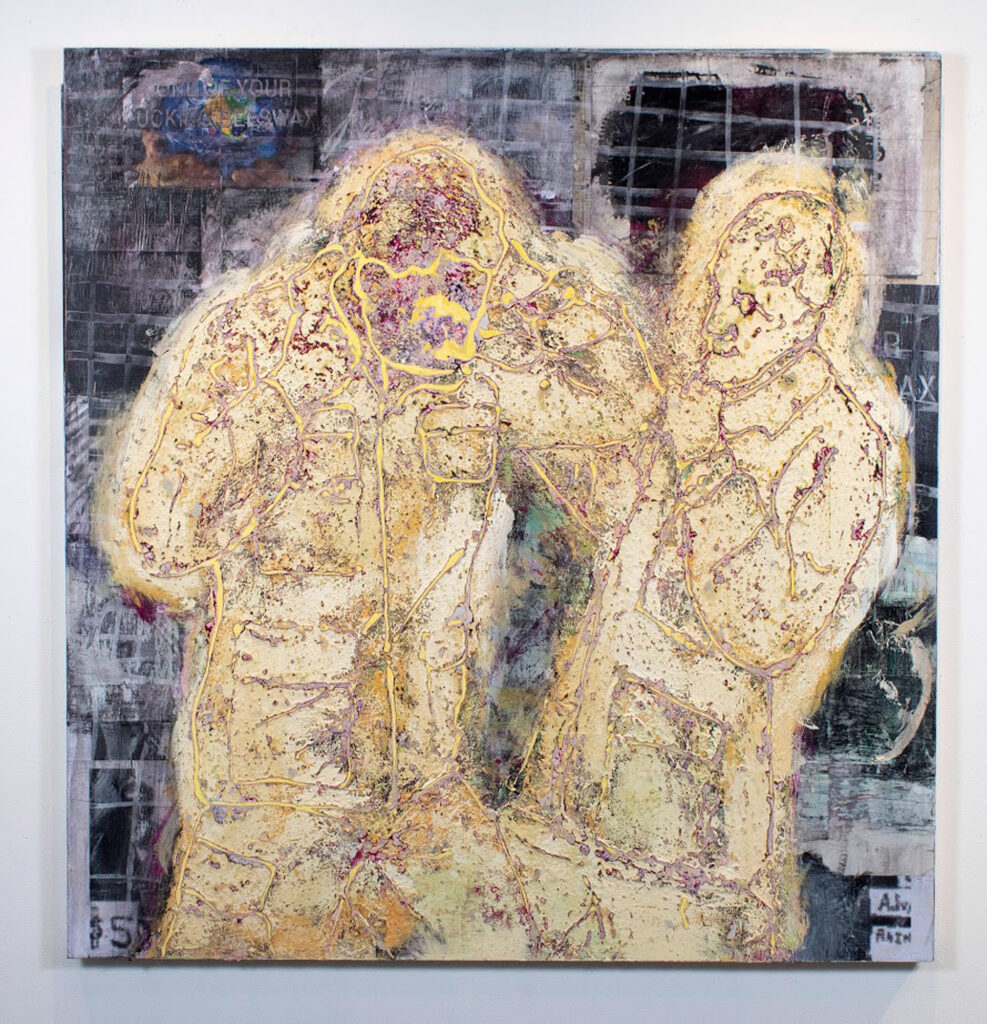

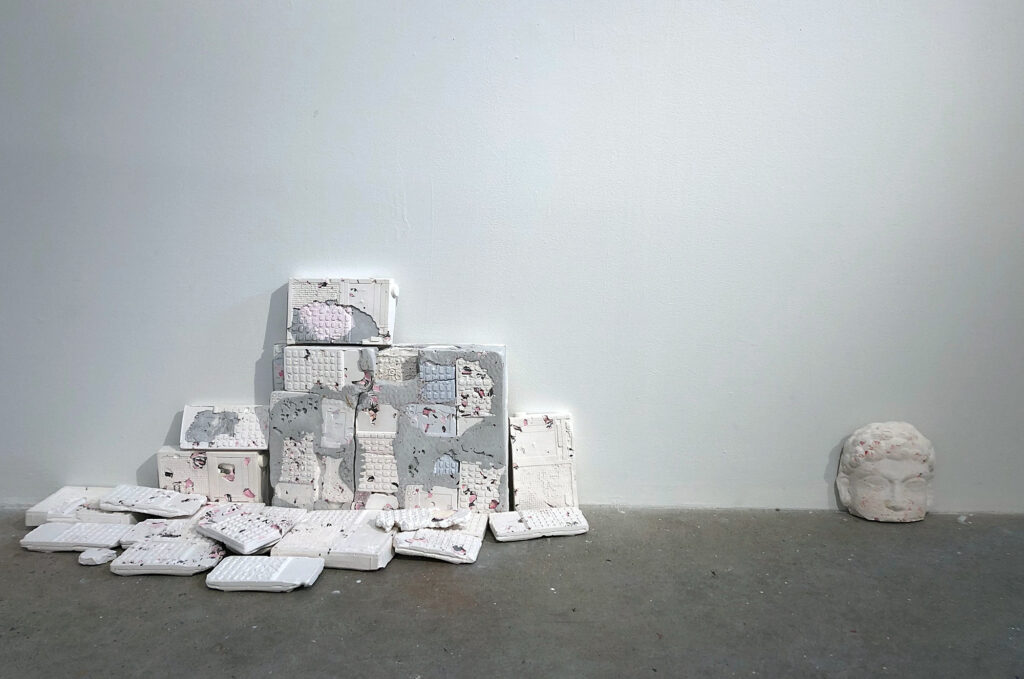
Our visions of the future are often just a confused jumble of the past: we reanimate old ideas and images when imagining the things to come. Prime examples of this can be seen in science fiction, where we find Star Trek ships encountering societies resembling Ancient Rome or Nazi Germany while exploring the edges of the galaxy. Even when imagining new worlds we find ones that resemble our own. In my recent work, I explore this phenomena by melding the aesthetic qualities that we associate with the historical and futuristic, challenging what seems to be the most fundamental binary in existence. By creating material situations where the past and future meet, I want to reach a better understanding of what shapes these concepts and why they affect us so deeply.
Theodore Golden
Hamilton College, BA
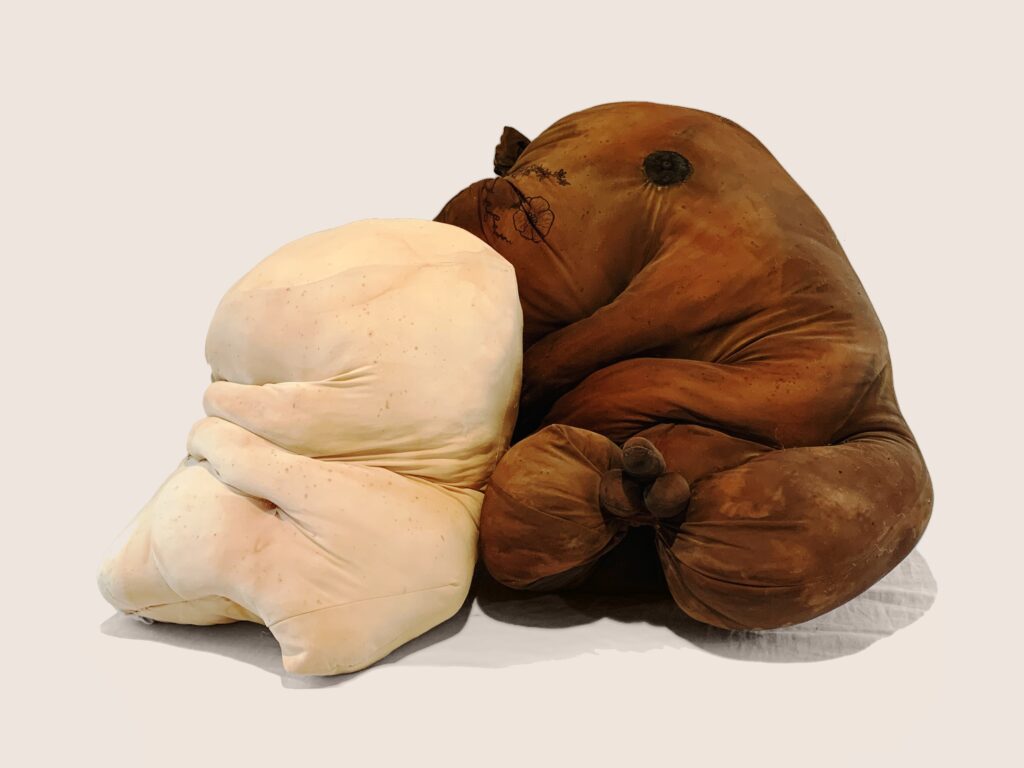
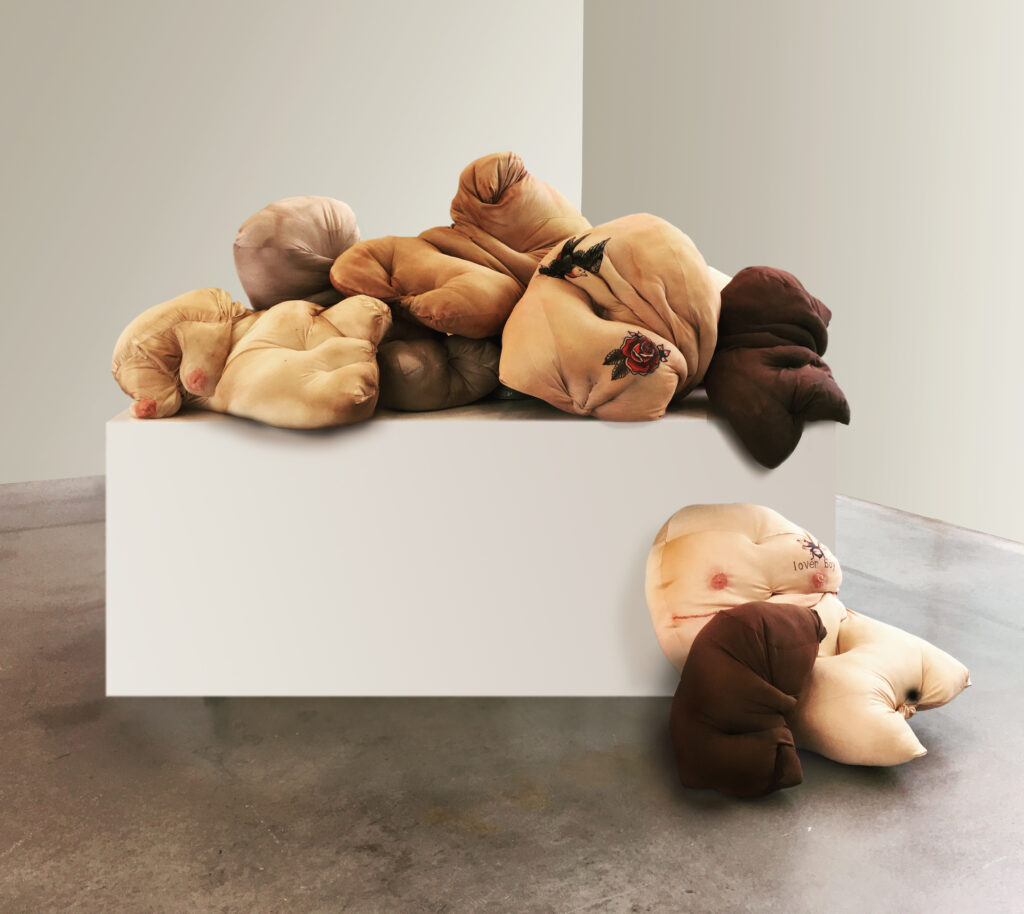
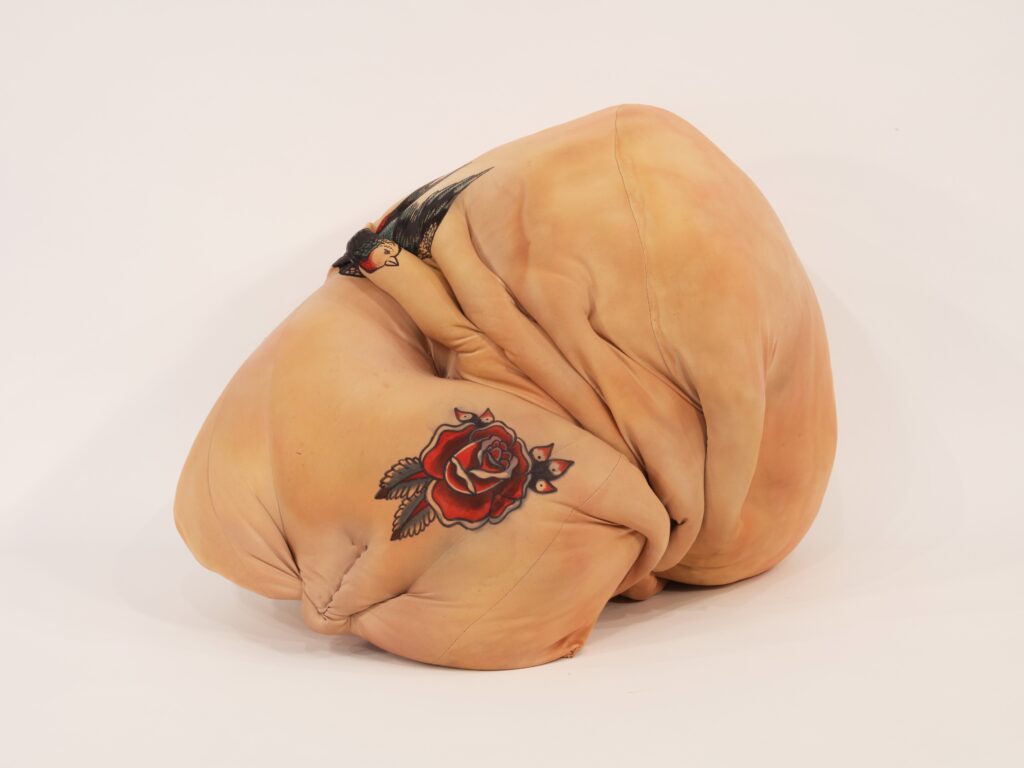
I am a multimedia artist and advocate interested in the physicality of the body. Taking inspiration from my experience as a transgender man, and thus my own altered and ever changing body, I create large fiber sculptures reminiscent of the human form. These “pillows,” as I call them, are meant to evoke feelings of intimacy, comfort, transformation, and familiarity, while still maintaining the aura of discomfort and mystery that we all feel in relation to our own physical bodies. By placing these forms together in an installation I hope to evoke a feeling of community, sensuality, and physicality, while also juxtaposing “unusual” or “altered” bodies against conventional bodies to promote normalization of transgender, tattooed, fat, and/or minority bodies among us in our communities.
Xuemeng Zhang
Clark University, BA
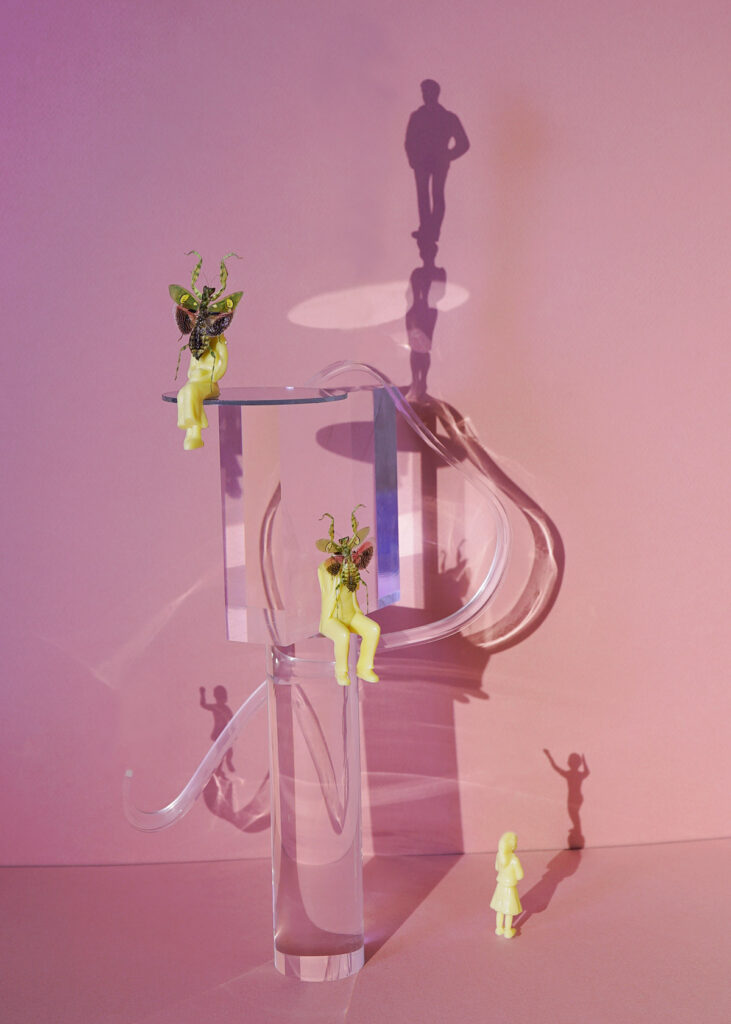
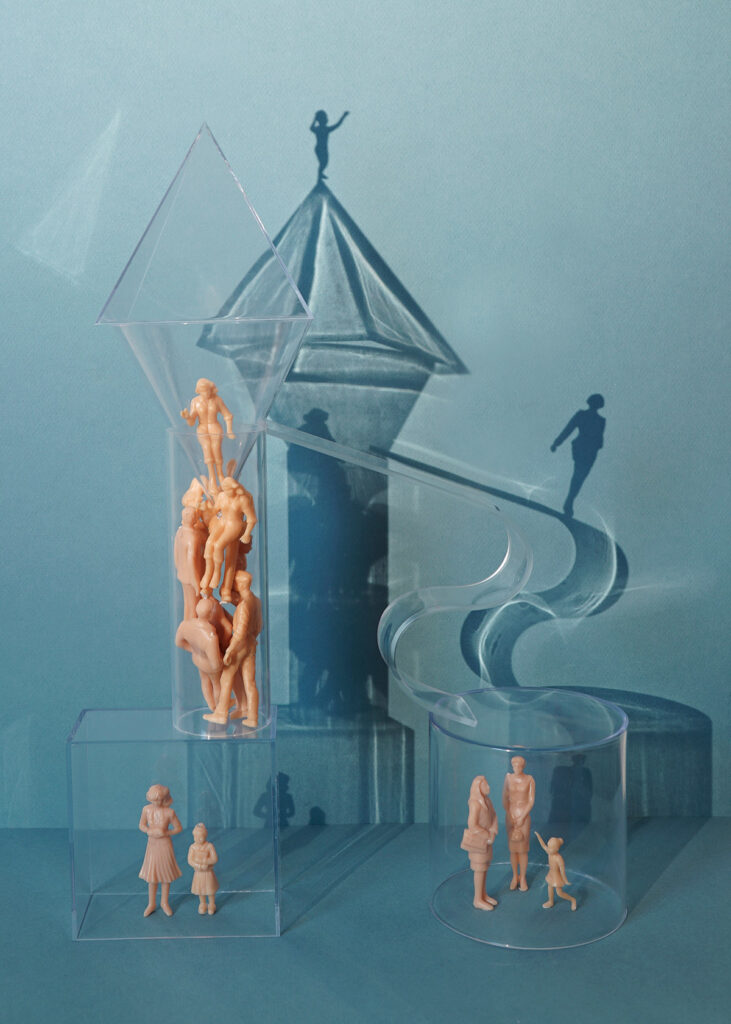
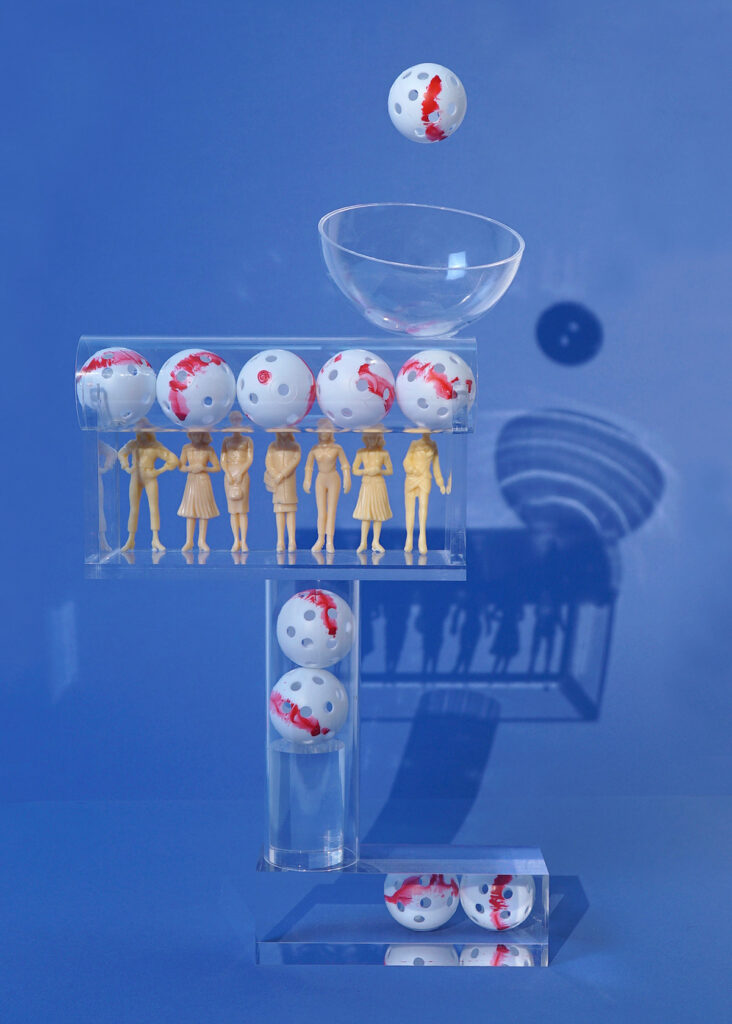
In the first half of 2020, the rapid spread of COVID-19 broke into everyone’s life. When the first case of coronavirus occurred, it seemed so far away. Most could not imagine its impact until it got closer and closer to us physically. Emotionally, it was never far away. As a Chinese student studying abroad in the U.S., I witnessed how the crisis first impacted the lives of my families, friends, and citizens, then became a global crisis where all humans must stand together to fight.
During this difficult time, uncertainty raises fear, crisis reveals inequality, self-interest conceals empathy, and prejudice instigates hatred. As a lens-based artist, I felt obligated to record and lay bare these issues using the language of photography. Through the construction of small scenes and the play of shadow, I document stories of this unusual time and express my deepest feelings as a witness to history. Objects in the photographs are narrators, revealing the stories of us all.
Zoila Coc-Chang
Brandeis University, BA
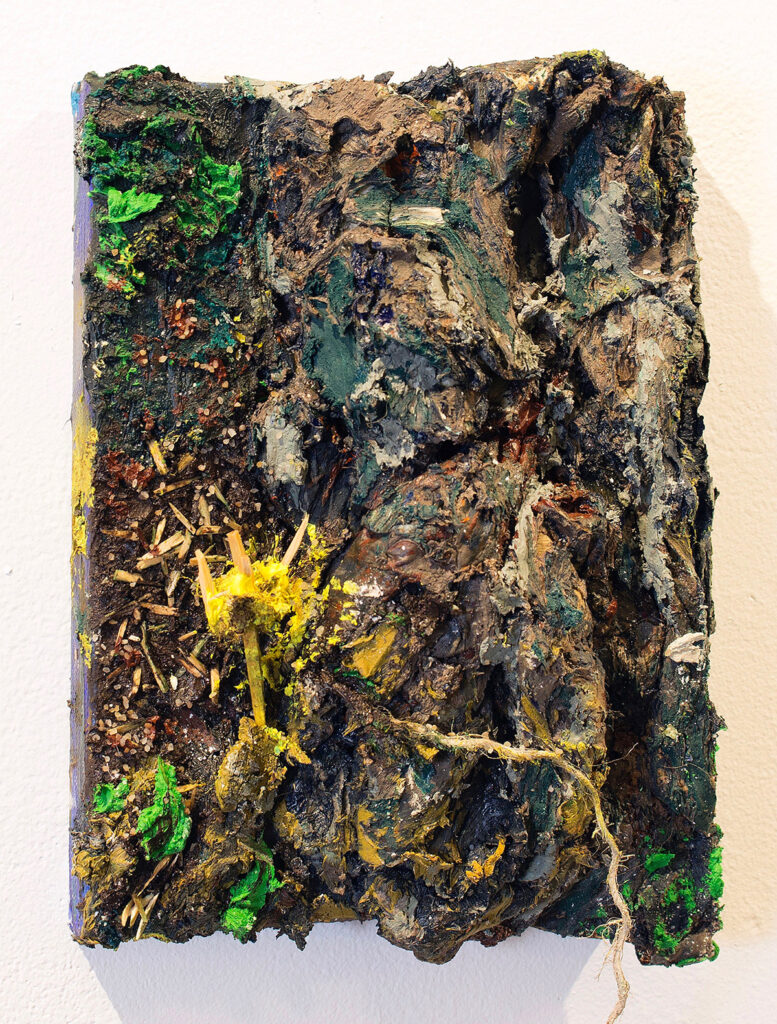
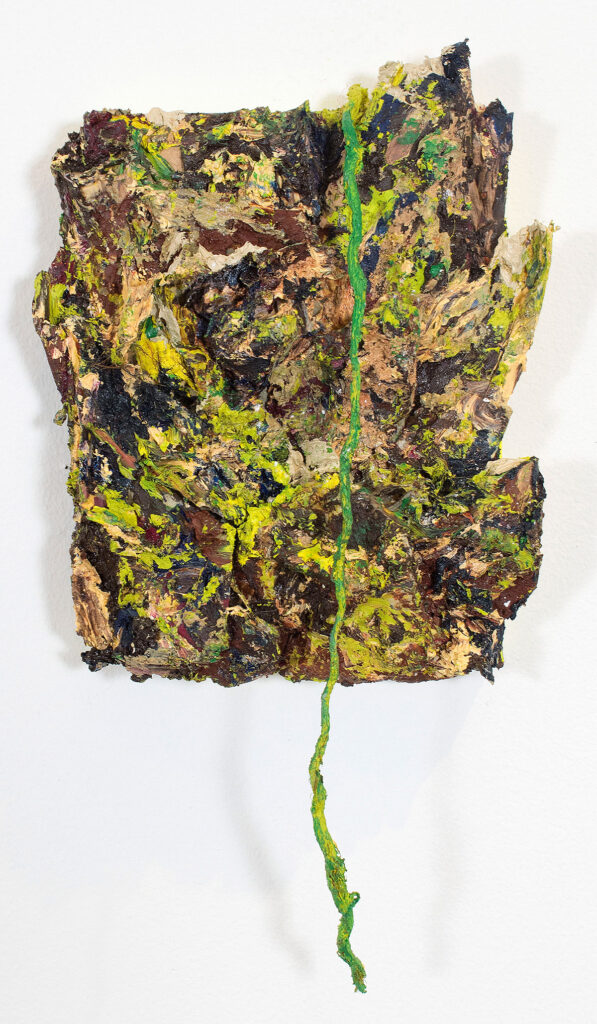

My work creates spaces addressing my curiosities and anxieties regarding migration, generational displacement, and multiculturalism. From studying afro-futurism, I’ve learned a valuable lesson that people need to not only understand the world around them, but also see themselves in the things they learn. I didn’t always see myself represented in environments, so I began to make my own. World building is crucial and comes naturally as we try to understand ourselves and the roles we wish to play. I create hybrid worlds that have transplanted species from Guatemala and Hong Kong, intermingled with Floridian plants. As a Chinese-Guatemalan living in America, my practice embodies the notions of hybridity within culture and home. My work challenges the representation of culture and identity by using ecology to demonstrate the fluidity of exchange.